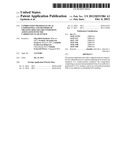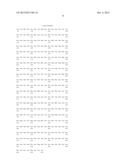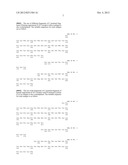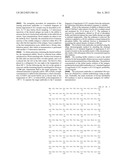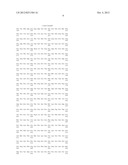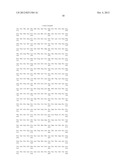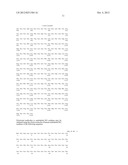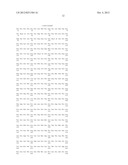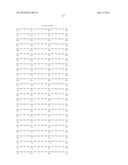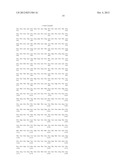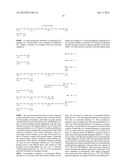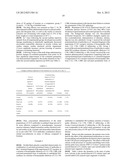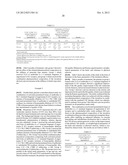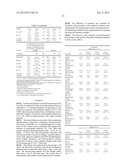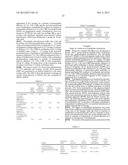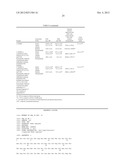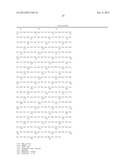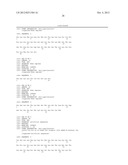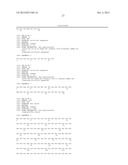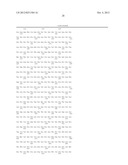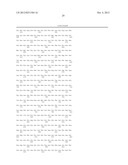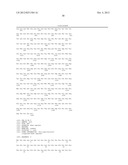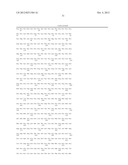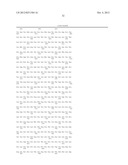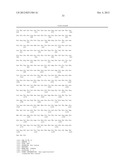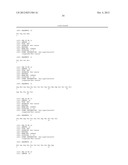Patent application title: Combination pharmaceutical composition and methods of treating diseases or conditions associated with the cardiovascular system
Inventors:
Oleg Iliich Epshtein (Moscow, RU)
Oleg Iliich Epshtein (Moscow, RU)
Svetlana Alexandrovna Sergeeva (Moscow, RU)
Liudmila Fyodorovna Dolgovyh (Chelyabinsk, RU)
Vladmir Ivanovich Petrov (Volgograd, RU)
IPC8 Class: AA61K39395FI
USPC Class:
424400
Class name: Drug, bio-affecting and body treating compositions preparations characterized by special physical form
Publication date: 2012-10-04
Patent application number: 20120251584
Abstract:
The present application provides a pharmaceutical composition for
administration to a patient suffering from at least one symptom of a
cardiovascular condition, the composition comprising a) an
activated-potentiated form of an antibody to angiotensin II AT1 receptor,
and b) an activated-potentiated form of an antibody to endothelial
NO-synthase.Claims:
1. A combination pharmaceutical composition for administration to a
patient suffering from at least one symptom of a cardiovascular
condition, said composition comprising a) an activated-potentiated form
of an antibody to angiotensin II AT1 receptor, and b) an
activated-potentiated form of an antibody to endothelial NO-synthase.
2. The combination pharmaceutical composition of claim 1, wherein said activated-potentiated form of an antibody to angiotensin II AT1 receptor is an activated-potentiated form of an antibody to the C-terminal fragment of the angiotensin II AT1 receptor.
3. The combination pharmaceutical composition of claim 1, wherein said cardiovascular condition is associated with a reduced quality of life of said patient and wherein said administration of said pharmaceutical composition to said patient improves said quality of life of said patient.
4. The combination pharmaceutical composition of claim 1, wherein said activated-potentiated form of an antibody to angiotensin II AT1 receptor is in the form of a C12, C30, or C200 homeopathic dilution or a mixture thereof.
5. The combination pharmaceutical composition of claim 1, wherein said activated-potentiated form of an antibody to angiotensin II AT1 receptor is in the form of a mixture of C12, C30, and C200 homeopathic dilutions impregnated onto a solid carrier.
6. The combination pharmaceutical composition of claim 1, wherein said activated-potentiated form of an antibody to endothelial NO-synthase is in the form of a C12, C30, or C200 homeopathic dilution or a mixture thereof.
7. The combination pharmaceutical composition of claim 1, wherein said activated-potentiated form of an antibody to endothelial NO-synthase is in the form of mixture of C12, C30, and C200 homeopathic dilutions impregnated onto a solid carrier.
8. The combination pharmaceutical composition of claim 1, which is prepared by impregnating a solid carrier with a mixture of i) said activated-potentiated form of an antibody to endothelial NO-synthase is in the form of mixture of C12, C30, and C200 homeopathic dilutions, and ii) said activated-potentiated form of an antibody to angiotensin II AT1 receptor is in the form of mixture of C12, C30, and C200 homeopathic dilutions.
9. The combination pharmaceutical composition of claim 1, wherein said activated-potentiated form of an antibody to angiotensin II AT1 receptor is a monoclonal, polyclonal or natural antibody.
10. The combination pharmaceutical composition of claim 9, wherein said activated-potentiated form of an antibody to angiotensin II AT1 receptor is a polyclonal antibody.
11. The combination pharmaceutical composition of claim 8, wherein said activated-potentiated form of an antibody to angiotensin II AT1 receptor is prepared by successive centesimal dilutions coupled with shaking of every dilution.
12. The combination pharmaceutical composition of claim 1, wherein said activated-potentiated form of an antibody to endothelial NO-synthase is a monoclonal, polyclonal or natural antibody.
13. The combination pharmaceutical composition of claim 12, wherein said activated-potentiated form of an antibody to endothelial NO-synthase is a polyclonal antibody.
14. The combination pharmaceutical composition of claim 8, wherein said activated-potentiated form of an antibody to endothelial NO-synthase is prepared by successive centesimal dilutions coupled with shaking of every dilution.
15. A method of treating a patient suffering from a reduced overall quality of life associated with at least one symptom of a cardiovascular condition, said method comprising administering to said patient substantially at the same time a) an activated-potentiated form of an antibody to angiotensin II AT1 receptor, and b) an activated-potentiated form of an antibody to endothelial NO-synthase, thereby said administration improves said overall quality of life of said patient.
16. The method of claim 15, wherein said activated-potentiated form of an antibody to angiotensin II AT1 receptor is an activated-potentiated form of an antibody to the C-terminal fragment of the angiotensin II AT1 receptor.
17. The method of claim 15 wherein said a) an activated-potentiated form of an antibody to angiotensin II AT1 receptor, and b) an activated-potentiated form of an antibody to endothelial NO-synthase are administered in the form of a combined pharmaceutical composition.
18. The method of claim 15, further comprising concomitantly administering to said patient an additional therapeutic agent suitable for administration to patients suffering from said at least one symptom of a cardiovascular condition.
19. The method of claim 18, wherein said additional therapeutic agent is selected from the group consisting of ACE inhibitors, diuretics; 6-adrenergic blockers, nitrates, cardiac glycosides, calcium antagonists, hypolipidemic agents, antiaggregants, antihypoxants, and anticoagulants.
20. The method of claim 19, wherein said additional therapeutic agent is bisoprol, enalapril or aspirin.
21. The method of claim 15 wherein said patient is administered said composition in the form of a solid unit dosage form comprising said activated-potentiated form of an antibody to angiotensin II AT1 receptor and said activated-potentiated form of an antibody to endothelial NO-synthase.
22. The method of claim 21, wherein said patient is administered one to two of said unit dosage forms, each administration carried out from once daily to four times daily.
23. The method of claim 15, which comprises administration of from one to two unit dosage forms of said activated-potentiated form of an antibody to angiotensin II AT1 receptor, and from one to two unit dosage forms of said activated-potentiated form of an antibody to endothelial NO-synthase, each of said dosage forms being administered from once daily to four times daily.
24. The method of claim 23, wherein each of said unit dosage form is administered twice daily.
25. The method of claim 15, wherein said cardiovascular condition is chronic heart failure.
26. The method of claim 15, wherein said patient exhibits statistically significant improvement in rigidity parameters of carotid radial artery segments upon said administration.
27. The method of claim 15, wherein said cardiovascular condition is asthenia and/or vegetative vascular dystonia.
28. The method of claim 27, wherein said administration of said combination leads to a statistically significant improvement in the mental asthenia by the MFI-20 scale in a suitable population of said patients in reference to the baseline.
29. The method of claim 27, wherein said administration of said combination leads to a statistically significant reduction in the general asthenia by the MFI-20 scale in a suitable population of said patients in reference to the baseline.
30. The method of claim 15, wherein said reduced overall quality of life is associated with anxiety related to said cardiovascular condition.
31. The method of claim 30, wherein said administration of said combination leads to a statistically significant improvement in the Minnesota Total Inventory Score in a suitable population of said patients in reference to the baseline.
32. The method of claim 15, wherein said reduced overall quality of life is associated with depression related to said cardiovascular condition.
33. The method of claim 32, wherein said administration of said combination leads to a statistically significant reduction in the Beck Questionnaire Score in a suitable population of said patients in reference to the baseline.
34. The method of claim 15, wherein said activated-potentiated form of an antibody to angiotensin II AT1 receptor is a monoclonal, polyclonal or natural antibody.
35. The method of claim 15, wherein said activated-potentiated form of an antibody to angiotensin II AT1 receptor is a polyclonal antibody.
36. The method of claim 15, wherein said activated-potentiated form of an antibody to endothelial NO-synthase is a monoclonal, polyclonal or natural antibody.
37. The method of claim 15, wherein said activated-potentiated form of an antibody to endothelial NO-synthase is a polyclonal antibody.
38. A method of treating a patient suffering from chronic heart failure, said method comprising administering to said patient a combination of a) an activated-potentiated form of an antibody to angiotensin II AT1 receptor, and b) an activated-potentiated form of an antibody to endothelial NO-synthase.
39. The method of claim 38, wherein said activated-potentiated form of an antibody to angiotensin II AT1 receptor is an activated-potentiated form of an antibody to the C-terminal fragment of the angiotensin II AT1 receptor.
40. The method of claim 38, further comprising concomitant administration to said patient of an additional therapeutic agent selected from the group consisting of ACE inhibitors, diuretics; 6-adrenergic blockers, nitrates, cardiac glycosides, calcium antagonists, hypolipidemic agents, antiaggregants, antihypoxants, and anticoagulants.
41. The method of claim 40, wherein said therapeutic agent is selected from bisoprol, enalapril and aspirin.
42. The method of claim 38, wherein said patient is administered said composition in the form of a solid unit dosage form comprising said activated-potentiated form of an antibody to angiotensin II AT1 receptor and said activated-potentiated form of an antibody to endothelial NO-synthase.
43. The method of claim 42, wherein said patient is administered one to two of said unit dosage forms, each administration carried out from once daily to four times daily.
44. The method of claim 38, which comprises administration of from one to two unit dosage forms of said activated-potentiated form of an antibody to angiotensin II AT1 receptor, and from one to two unit dosage forms of said activated-potentiated form of an antibody to endothelial NO-synthase, each of said dosage forms being administered from once daily to four times daily.
45. The method of claim 38, wherein said patient exhibit statistically significant improvement in rigidity parameters of carotid radial artery segments upon said administration.
46. The method of claim 45, wherein said patient exhibit statistically significant improvement in rigidity parameters of carotid femoral artery segments upon said administration.
47. The method of claim 38, wherein said patient exhibits statistically significant reduction in anxiety associated with said chronic heart failure upon said administration.
48. The method of claim 47, wherein said administration of said combination leads to a statistically significant improvement in the Minnesota Total Inventory Score in a suitable population of said patients in reference to the baseline.
49. The method of claim 47, wherein said administration of said combination leads to a statistically significant reduction in the Kansas City Cardiomyopathy Questionnaire Total Score in a suitable population of said patients in reference to the baseline.
50. The method of claim 38, wherein said administration of said combination leads to a statistically significant improvement in a 6-minute walking test score in a suitable population of said patients.
51. The method of claim 38, wherein said administration of said combination leads to a statistically significant improvement in the HADS Total score in a suitable population of said patients.
52. The method of claim 38, wherein said patient exhibits statistically significant reduction in depression associated with said chronic heart failure upon said administration.
53. The method of claim 38, wherein said activated-potentiated form of an antibody to a C-terminal fragment of the angiotensin II AT1 receptor is a monoclonal, polyclonal or natural antibody.
54. The method of claim 53, wherein said activated-potentiated form of an antibody to a C-terminal fragment of the angiotensin II AT1 receptor is a polyclonal antibody.
55. The method of claim 38, wherein said activated-potentiated form of an antibody to endothelial NO-synthase is a monoclonal, polyclonal or natural antibody.
56. The method of claim 55, wherein said activated-potentiated form of an antibody to endothelial NO-synthase is a polyclonal antibody.
57. A method of treating a patient suffering from asthenia and/or vegetative-vascular dystonia, said method comprising administering to said patient a combination of a) an activated-potentiated form of an antibody to angiotensin II AT1 receptor, and b) an activated-potentiated form of an antibody to endothelial NO-synthase.
58. The method of claim 57, wherein said activated-potentiated form of an antibody to angiotensin II AT1 receptor is an activated-potentiated form of an antibody to the C-terminal fragment of the angiotensin II AT1 receptor.
59. The method of claim 57, further comprising concomitant administration to said patient of an additional therapeutic agent selected from the group consisting of ACE inhibitors, diuretics; β-adrenergic blockers, nitrates, cardiac glycosides, calcium antagonists, hypolipidemic agents, antiaggregants, antihypoxants, and anticoagulants.
60. The method of claim 59, wherein said additional therapeutic agent is selected from bisoprol, enalapril and aspirin.
61. The method of claim 59, wherein said patient is administered said composition in the form of a solid unit dosage form comprising said activated-potentiated form of an antibody to angiotensin II AT1 receptor and said activated-potentiated form of an antibody to endothelial NO-synthase.
62. The method of claim 61, wherein said patient is administered one to two of said unit dosage forms, each administration carried out from once daily to four times daily.
63. The method of claim 59, which comprises administration of from one to two unit dosage forms of said activated-potentiated form of an antibody to angiotensin II AT1 receptor, and from one to two unit dosage forms of said activated-potentiated form of an antibody to endothelial NO-synthase, each of said dosage forms being administered from once daily to four times daily.
64. The method of claim 63, wherein said one to two unit dosage form of each of said activated-potentiated forms of antibodies is administered twice daily.
65. The method of claim 59, wherein said patient exhibit statistically significant improvement in rigidity parameters of carotid radial artery segments upon said administration.
66. The method of claim 65, wherein said patient exhibit statistically significant improvement in rigidity parameters of carotid femoral artery segments upon said administration.
67. The method of claim 57, wherein said patient exhibits statistically significant reduction in mental asthenia upon said administration.
68. The method of claim 67, wherein said administration of said combination leads to a statistically significant reduction in the mental asthenia by the MFI-20 scale in a suitable population of said patients in reference to the baseline.
69. The method of claim 57, wherein said patient exhibits statistically significant reduction in general asthenia upon said administration.
70. The method of claim 69, wherein said administration of said combination leads to a statistically significant reduction in the general asthenia by the MFI-20 scale in a suitable population of said patients in reference to the baseline.
71. The method of claim 57, wherein said patient exhibits statistically significant reduction in anxiety associated with said asthenia and/or vegetative vascular dystonia upon said administration.
72. The method of claim 71, wherein said administration of said combination leads to a statistically significant reduction in the trait anxiety as measured by Spielberg test in a suitable population of said patients in reference to the baseline.
73. The method of claim 57, wherein said patient exhibits statistically significant reduction in depression associated with said asthenia and/or vegetative vascular dystonia upon said administration.
74. The method of claim 73, wherein said administration of said combination leads to a statistically significant reduction in depression as measured by Beck test in a suitable population of said patients in reference to the baseline.
75. The method of claim 57, wherein said patient exhibits statistically significant improvement in brachial artery dilation level upon said administration.
76. The method of claim 57, wherein said activated-potentiated form of an antibody to a C-terminal fragment of the angiotensin II AT1 receptor is an antibody is a monoclonal, polyclonal or natural antibody.
77. The method of claim 76, wherein said activated-potentiated form of an antibody to a C-terminal fragment of the angiotensin II AT1 receptor is a polyclonal antibody.
78. The method of claim 77, wherein said activated-potentiated form of an antibody to a C-terminal fragment of the angiotensin II AT1 receptor is prepared by successive centesimal dilutions coupled with vertical shaking of every dilution.
79. The method of claim 57, wherein said activated-potentiated form of an antibody to endothelial NO-synthase is an antibody is a monoclonal, polyclonal or natural antibody.
80. The method of claim 79, wherein said activated-potentiated form of an antibody to endothelial NO-synthase is a polyclonal antibody.
81. A method of treating hypertension comprising administering the combination of claim 1 to a patient in need thereof.
82. The method of claim 81, further comprising concomitant administration to said patient of an additional therapeutic agent selected from the group consisting of ACE inhibitors, diuretics; β-adrenergic blockers, nitrates, cardiac glycosides, calcium antagonists, hypolipidemic agents, antiaggregants, antihypoxants, and anticoagulants.
Description:
FIELD
[0001] The present invention relates to the field of medicine and can be used for the treatment and prevention of diseases of the cardiovascular system.
BACKGROUND
[0002] Nitric oxide (NO) is a cellular signaling molecule which plays a role in many biological processes including the relaxation of vascular and non-vascular tissue. Nitric oxide is synthesized from L-arginine by nitric oxide synthase (NO synthase). NO synthase occurs in different isoforms, including a constitutive form (cNOS) and an inducible form (iNOS). The constitutive form is present in normal endothelial cells, neurons and some other tissues. Formation of nitric oxide by the constitutive form in endothelial cells is thought to play an important role in normal blood pressure regulation.
[0003] Angiotensin is a protein that causes blood vessels to constrict, and drives blood pressure up and stimulates the release of aldosterone from the adrenal cortex. Angiotensin is part of the renin-angiotensin system (a hormone system that regulates blood pressure and water (fluid) balance) which is a major target for drugs that lower blood pressure. Angiotensin II receptor type 1 (AT1) is believed to mediate the key effects of angiotensin II.
[0004] The therapeutic effect of an extremely diluted (or ultra-low) form of antibodies potentized by homeopathic technology has been discovered by the inventor of the present patent application, Dr. Oleg I. Epshtein. U.S. Pat. No. 7,582,294 discloses a medicament for treating Benign Prostatic Hyperplasia or prostatitis by administration of a homeopathically activated form of antibodies to prostate specific antigen (PSA). U.S. Patent Publication No. 2010/0260742 discloses a homeopathically potentized form of antibodies to a C-terminal fragment of the angiotensin II AT1 receptor. The homeopathically potentized form of antibodies to a C-terminal fragment of the angiotensin II AT1 receptor is marketed in the Russian Federation and other countries under the name Kardos®. U.S. Pat. No. 7,700,096 discloses and claims a homeopathically potentized form of antibodies to endothelial NO-synthase. The homeopathically potentized form of antibodies to endothelial NO-synthase is marketed in the Russian Federation and other countries under the name Impaza®.
[0005] There is a continuing need for new drug products with desired therapeutic efficacy for treatment of diseases and disorder of the cardiovascular system.
SUMMARY
[0006] In one aspect the invention provides a pharmaceutical composition for administration to a patient suffering from at least one symptom of a cardiovascular condition, said composition comprising a) an activated-potentiated form of an antibody to angiotensin II AT1 receptor, and b) an activated-potentiated form of an antibody to endothelial NO-synthase.
[0007] In one variant of this aspect of the invention a pharmaceutical composition for administration to a patient suffering from at least one symptom of a cardiovascular condition comprises a) an activated-potentiated form of an antibody to a C-terminal fragment of angiotensin II AT1 receptor, and b) an activated-potentiated form of an antibody to endothelial NO-synthase.
[0008] Preferably, the pharmaceutical composition of this aspect is administered to patients with cardiovascular condition(s) associated with a reduced quality of life, wherein the administration of said pharmaceutical composition to said patient improves said quality of life of said patient.
[0009] Various variants and embodiments of the pharmaceutical composition are contemplated and provided. They may be used in reference to method aspects and embodiments of the invention. The specific variants and embodiments of this aspect of the invention are set forth in the appended claims. Preferably, the pharmaceutical composition of the invention comprises activated-potentiated forms of polyclonal antibodies. It is also preferred that the process of preparing the pharmaceutical composition of this aspect of the invention includes successive centesimal dilutions coupled with vertical shaking of every dilution.
[0010] In another aspect, the invention provides a method of treating a patient suffering from a reduced overall quality of life associated with at least one symptom of a cardiovascular condition, said method comprising administering to said patient a combination of a) an activated-potentiated form of an antibody to angiotensin II AT1 receptor, and b) an activated-potentiated form of an antibody to endothelial NO-synthase, thereby said administration improves said overall quality of life of said patient. Preferably, the invention provides a method of treating a patient suffering from a reduced overall quality of life associated with at least one symptom of a cardiovascular condition, said method comprising administering to said patient a combination of a) an activated-potentiated form of an antibody to a C-terminal fragment of angiotensin II AT1 receptor, and b) an activated-potentiated form of an antibody to endothelial NO-synthase, thereby said administration improves said overall quality of life of said patient. Various variants and embodiments are contemplated. In particular, it is contemplated that the combination of this aspect of the invention is administered concomitantly with administration of an additional therapeutic agent suitable for administration to patients suffering from said at least one symptom of a cardiovascular condition. The non-limiting list of suitable additional agents includes ACE inhibitors, diuretics; β-adrenergic blockers, nitrates, cardiac glycosides, calcium antagonists, hypolipidemic agents, antiaggregants, antihypoxants, and anticoagulants. Bisoprol, enalapril or aspirin are specifically contemplated.
[0011] Particularly contemplated is a method of this aspect of the invention in which said patient is administered said composition in the form of a solid unit dosage form comprising said activated-potentiated form of an antibody to a C-terminal fragment of angiotensin II AT1 receptor and said activated-potentiated form of an antibody to endothelial NO-synthase. Preferably, said patient is administered one to two of said unit dosage forms, each administration carried out from once daily to four times daily.
[0012] In another aspect, the invention provides a method of treating a patient suffering from chronic heart failure, said method comprising administering to said patient a combination of a) an activated-potentiated form of an antibody to a C-terminal fragment of angiotensin II AT1 receptor, and b) an activated-potentiated form of an antibody to endothelial NO-synthase. Various variants and embodiments are contemplated. In particular, it is contemplated that the combination of this aspect of the invention is administered concomitantly with administration of an additional therapeutic agent suitable for administration to patients suffering from said at least one symptom of a cardiovascular condition. The non-limiting list of suitable additional agents includes ACE inhibitors, diuretics; β-adrenergic blockers, nitrates, cardiac glycosides, calcium antagonists, hypolipidemic agents, antiaggregants, antihypoxants, and anticoagulants. Bisoprol, enalapril or aspirin are specifically contemplated.
[0013] Particularly contemplated is a method of this aspect of the invention in which said patient is administered said composition in the form of a solid unit dosage form comprising said activated-potentiated form of an antibody to a C-terminal fragment of angiotensin II AT1 receptor and said activated-potentiated form of an antibody to endothelial NO-synthase. Preferably, said patient is administered one to two of said unit dosage forms, each administration carried out from once daily to four times daily. In accordance with this aspect of the invention, said patient exhibits statistically significant improvement in rigidity parameters of carotid radial artery segments upon said administration. In accordance with this aspect of the invention, said patient exhibits statistically significant improvement in rigidity parameters of carotid femoral artery segments upon said administration. In accordance with this aspect of the invention, said patient exhibits statistically significant reduction in anxiety associated with said chronic heart failure upon said administration. It is particularly contemplated that said administration of said combination leads to a statistically significant improvement in the The Minnesota Living with Heart Failure questionnaire (MLHFQ) score in a suitable population of said patients in reference to the baseline. It is particularly contemplated that said administration of said combination leads to a statistically significant reduction in the Kansas City Cardiomyopathy Questionnaire total Score in a suitable population of said patients in reference to the baseline. It is particularly contemplated that said administration of said combination leads to a statistically significant improvement in a 6-minute walking test score in a suitable population of said patients. It is particularly contemplated that said administration of said combination leads to a statistically significant improvement in the Hospital Anxiety and Depression Scale (HADS) total score in a suitable population of said patients. It is particularly contemplated that said administration of said combination leads to said patient exhibiting statistically significant reduction in depression associated with said chronic heart failure upon said administration.
[0014] In another aspect, the invention provides a method of treating a patient suffering from asthenia and/or vegetative-vascular dystonia, said method comprising administering to said patient a combination of a) an activated-potentiated form of an antibody to a C-terminal fragment of angiotensin II AT1 receptor, and b) an activated-potentiated form of an antibody to endothelial NO-synthase. Various variants and embodiments are contemplated. In particular, it is contemplated that the combination of this aspect of the invention is administered concomitantly with administration of an additional therapeutic agent suitable for administration to patients suffering from said at least one symptom of a cardiovascular condition. The non-limiting list of suitable additional agents includes ACE inhibitors, diuretics; β-adrenergic blockers, nitrates, cardiac glycosides, calcium antagonists, hypolipidemic agents, antiaggregants, antihypoxants, and anticoagulants. Bisoprol, enalapril or aspirin are specifically contemplated.
[0015] It is particularly contemplated in accordance with this aspect of the invention that said patient exhibits statistically significant improvement in rigidity parameters of carotid radial artery segments upon said administration. It is particularly contemplated that said patient exhibits statistically significant improvement in rigidity parameters of carotid femoral artery segments upon said administration. It is particularly contemplated that said patient exhibits statistically significant reduction in mental asthenia upon said administration. Preferably, said administration of said combination leads to a statistically significant reduction in the mental asthenia by the Multidimensional Fatigue Inventory (MFI-20) scale in a suitable population of said patients in reference to the baseline. Preferably, the administration of the combination drug or medicine in accordance with this aspect of the invention leads to said patient exhibiting statistically significant reduction in general asthenia upon said administration. Preferably, said administration of said combination leads to a statistically significant reduction in the general asthenia by the MFI-20 scale in a suitable population of said patients in reference to the baseline. Preferably, said patient exhibits statistically significant reduction in anxiety associated with said asthenia and/or vegetative vascular dystonia upon said administration. It is preferred that in accordance with this aspect of the invention, said administration of said combination drug or medicine leads to a statistically significant reduction in the trait anxiety as measured by the Spielberg test in a suitable population of said patients in reference to the baseline. Preferably, said patient exhibits statistically significant reduction in depression associated with said asthenia and/or vegetative vascular dystonia upon said administration. It is particularly contemplated that said administration of said combination drug or medicine leads to a statistically significant reduction in depression as measured by the Beck test in a suitable population of said patients in reference to the baseline. Preferably, said patient exhibits statistically significant improvement in brachial artery dilation level upon said administration.
[0016] In another aspect, the invention provides a method of treating hypertension comprising administering the combination described herein to a patient in need thereof. Concomitant administration of an additional therapeutic agent selected from the group consisting of ACE inhibitors, diuretics; β-adrenergic blockers, nitrates, cardiac glycosides, calcium antagonists, hypolipidemic agents, antiaggregants, antihypoxants, and anticoagulants is specifically contemplated.
DETAILED DESCRIPTION
[0017] The invention is defined with reference to the appended claims. With respect to the claims, the glossary that follows provides the relevant definitions.
[0018] The term "antibody" as used herein shall mean an immunoglobulin that specifically binds to, and is thereby defined as complementary with, a particular spatial and polar organization of another molecule. Antibodies as recited in the claims may include a complete immunoglobulin or fragment thereof, may be natural, polyclonal or monoclonal, and may include various classes and isotypes, such as IgA, IgD, IgE, IgG1, IgG2a, IgG2b and IgG3, IgM, etc. Fragments thereof may include Fab, Fv and F(ab')2, Fab', and the like. The singular "antibody" includes plural "antibodies".
[0019] The term "activated-potentiated form" or "potentiated form", respectively, with respect to antibodies recited herein is used to denote a product of homeopathic potentization of any initial solution of antibodies. "Homeopathic potentization" denotes the use of methods of homeopathy to impart homeopathic potency to an initial solution of relevant substance. Although not so limited, "homeopathic potentization" may involve, for example, repeated consecutive dilutions combined with external treatment, particularly (mechanical) shaking. In other words, an initial solution of antibody is subjected to consecutive repeated dilution and multiple vertical shaking of each obtained solution in accordance with homeopathic technology. The preferred concentration of the initial solution of antibody in the solvent, preferably, water or a water-ethyl alcohol mixture, ranges from about 0.5 to about 5.0 mg/ml. The preferred procedure for preparing each component, i.e. antibody solution, is the use of the mixture of three aqueous or aqueous-alcohol dilutions of the primary matrix solution (mother tincture) of antibodies diluted 10012, 10030 and 100200 times, respectively, which is equivalent to centesimal homeopathic dilutions C12, C30 and C200. Examples of homeopathic potentization are described in U.S. Pat. Nos. 7,572,441 and 7,582,294, which are incorporated herein by reference in their entirety and for the purpose stated. While the term "activated-potentiated form" is used in the claims, the term "ultra-low doses" is used in the examples. The term "ultra-low doses" became a term of art in the field of art created by study and use of homeopathically diluted and potentized form of substance. The term "ultra-low dose" or "ultra-low doses" is meant as fully supportive and primarily synonymous with the term "activated-potentiated" form used in the claims.
[0020] In other words, an antibody is in the "activated-potentiated" form when three factors are present. First, the "activated-potentiated" form of the antibody is a product of a preparation process well accepted in the homeopathic art. Second, the "activated-potentiated" form of antibody must have biological activity determined by methods well accepted in modern pharmacology. And third, the biological activity exhibited by the "activated-potentiated" form of the antibody cannot be explained by the presence of the molecular form of the antibody in the final product of the homeopathic process.
[0021] For example, the activated potentiated form of antibodies may be prepared by subjecting an initial, isolated antibody in a molecular form to consecutive multiple dilutions coupled with an external impact, such as mechanical shaking. The external treatment in the course of concentration reduction may also be accomplished, for example, by exposure to ultrasonic, electromagnetic, or other physical factors. V. Schwabe "Homeopathic medicines", M., 1967, U.S. Pat. Nos. 7,229,648 and 4,311,897, which are incorporated by reference in their entirety and for the purpose stated, describe such processes which are well accepted methods of homeopathic potentiation in the homeopathic art. This procedure gives rise to a uniform decrease in molecular concentration of the initial molecular form of the antibody. This procedure is repeated until the desired homeopathic potency is obtained. For the individual antibody, the required homeopathic potency can be determined by subjecting the intermediate dilutions to biological testing in the desired pharmacological model. Although not so limited, "homeopathic potentization" may involve, for example, repeated consecutive dilutions combined with external treatment, particularly vertical (mechanical) shaking. In other words, an initial solution of antibody is subjected to consecutive repeated dilution and multiple vertical shaking of each obtained solution in accordance with homeopathic technology. The preferred concentration of the initial solution of antibody in the solvent, preferably, water or a water-ethyl alcohol mixture, ranges from about 0.5 to about 5.0 mg/ml. The preferred procedure for preparing each component, i.e. antibody solution, is the use of the mixture of three aqueous or aqueous-alcohol dilutions of the primary matrix solution (mother tincture) of antibodies diluted 10012, 10030 and 100200 times, respectively, which is equivalent to centesimal homeopathic dilutions C12, C30 and C200 or the mixture of three aqueous or aqueous-alcohol dilutions of the primary matrix solution (mother tincture) of antibodies diluted 10012, 10030 and 10050 times, respectively, which is equivalent to centesimal homeopathic dilutions C12, C30 and C50. Examples of how to obtain the desired potency are also provided, for example, in U.S. Pat. Nos. 7,229,648 and 4,311,897, which are incorporated by reference for the purpose stated. The procedure applicable to the "activated potentiated" form of the antibodies described herein is described in more detail below.
[0022] There has been a considerable amount of controversy regarding homeopathic treatment of human subjects. While the present invention relies on accepted homeopathic processes to obtain the "activated-potentiated" form of antibodies, it does not rely solely on homeopathy in human subjects for evidence of activity. It has been surprisingly discovered by the inventor of the present application and amply demonstrated in the accepted pharmacological models that the solvent ultimately obtained from consecutive multiple dilution of a starting molecular form of an antibody has definitive activity unrelated to the presence of the traces of the molecular form of the antibody in the target dilution. The "activated-potentiated" form of the antibody provided herein are tested for biological activity in well accepted pharmacological models of activity, either in appropriate in vitro experiments, or in vivo in suitable animal models. The experiments provided further below provide evidence of biological activity in such models. The human clinical studies, also provided herein below, inter alia provide evidence that the activity observed in the animal model is well translated to human therapy. The human study also provides evidence of availability of the "activated potentiated" forms described herein to treat specified human diseases or disorders well accepted as pathological conditions in the medical science.
[0023] Also, the claimed "activated-potentiated" form of antibody encompasses only solutions or solid preparations the biological activity of which cannot be explained by the presence of the molecular form of the antibody remaining from the initial, starting solution. In other words, while it is contemplated that the "activated-potentiated" form of the antibody may contain traces of the initial molecular form of the antibody, one skilled in the art could not attribute the observed biological activity in the accepted pharmacological models to the remaining molecular form of the antibody with any degree of plausibility due to the extremely low concentrations of the molecular form of the antibody remaining after the consecutive dilutions. While the invention is not limited by any specific theory, the biological activity of the "activated-potentiated" form of the antibodies of the present invention is not attributable to the initial molecular form of the antibody. Preferred is the "activated-potentiated" form of antibody in liquid or solid form in which the concentration of the initial molecular form of the antibody is below the limit of detection of the accepted analytical techniques, such as capillary electrophoresis and High Performance Liquid Chromatography. Particularly preferred is the "activated-potentiated" form of antibody in liquid or solid form in which the concentration of the initial molecular form of the antibody is below the Avogadro number. In pharmacology of molecular forms of therapeutic substances, it is common practice to create a dose-response curve in which the level of pharmacological response is plotted against the concentration of the active drug administered to the subject or tested in vitro. The minimal level of the drug which produces any detectable response is known as a threshold dose. It is specifically contemplated and preferred that the "activated-potentiated" form of the antibodies contains molecular antibody, if any, at a concentration below the threshold dose for the molecular form of the antibody in the given biological model. The specific compositions described in the appended examples are described with the term ultra-low doses (ULD), which term is not intended to be used in construing the claims of the present application.
[0024] The term "cardiovascular condition" denotes disease or disorder of the cardiovascular system in human defined as such in the medical profession. Non-limiting examples of cardiovascular conditions include heart failure, arterial hypertension, and asthenia.
[0025] The term "symptom" with respect to "cardiovascular conditions" denotes those manifestations of patients suffering from diseases or disorders of the cardiovascular system that reduce quality of life of such patients. Non-limiting examples of symptoms of cardiovascular conditions that reduce quality of life include anxiety, depression, and walking difficulty.
[0026] The term "quality of life" denotes the subjective feeling of well-being of a patient. The quality of life of a patient increases with reduction in or improvement of symptoms. The term "quality of life" is meant to define the collection of symptoms associated with cardiovascular deceases or disorders in a patient population.
[0027] The term "MFI-20 scale" refers to "multidimensional fatigue inventory", which is a 20-question inventory questionnaire used to measure the levels of physical, psychological and mental fatigue. It denotes the MFI-20 questionnaire commonly used by those skilled in the art. An example of use of the MFI-20 scale to assess fatigue in patients with chronic heart failure may be found in K. Falk et al., Fatigue and Anaemia in Patients with Chronic Heart Failure, European Journal of Heart Failure, 8, 744-749 (2006), which is incorporated herein by reference.
[0028] The term "The Minnesota Living with Heart Failure questionnaire" (MLHFQ), also referred to as the Minnesota questionnaire, refers to a well-established questionnaire commonly used to assess quality of life and levels of anxiety in people with cardiovascular conditions, and heart failure in particular.
[0029] The content of the Minnesota questionnaire is representative of the ways cardiovascular conditions, and particularly heart failure, together with appropriate treatments, affect the physical, emotional, social and mental dimensions of quality of life. The questionnaire focuses on questions that assess the impact of frequent physical symptoms--shortness of breath, fatigue, peripheral edema, and sleeping difficulty, and psychological symptoms of anxiety and depression. In addition, the effects of heart failure on physical/social functions including walking, climbing stairs, household work, need to rest, working to earn a living, going places away from home, doing things with family or friends, recreational activities, sexual activities, eating and mental and emotional functions of concentration, memory, loss of self-control, and being a burden to others were incorporated into the measure. Since treatments might have side effects in addition to ameliorating symptoms and functional limitations produced by heart failure, questions about side effects of medications, hospital stays and costs of care are included to help measure the overall impact of a treatment on quality of life. To measure the effects of symptoms, functional limitations, psychological distress on an individual's quality of life, the questionnaire asks each person to indicate using a 6-point, zero to five, Likert scale how much each of 21 facets prevented them from living as they desired. This response format is consistent with the concept of quality of life and allows each individual to weigh each item using a common scale. Therefore, one can look at which items had the most effect and the sum of responses reflects the overall effects of heart failure and treatments on the individual's quality of life. Although the Minnesota Living with Heart Failure Questionnaire incorporates relevant aspects of the key dimensions of quality of life, the questionnaire was not designed to measure any particular dimension separately. Given the conceptual basis for the questionnaire, items on the questionnaire are considered to be `causal` indicators of quality of life in the sense that they can affect someone's quality of life when they occur, but may not be present when other aspects of heart failure are affecting an individual's quality of life. The total score is taken as the best measure of how cardiovascular condition, and particularly heart failure, and commensurate treatments impact the quality of life.
[0030] The term "Kansas City Cardiomyopathy Questionnaire" (KCCQ) or "Kansas Questionnaire" refers to a health-related quality-of-life measure for patients with congestive heart failure. It is a reliable, predictive tool that tracks how patients are doing if they have weakened heart muscle due to prior heart attacks, heart valve problems, viral infections, or other causes.
[0031] The answers patients give to the KCCQ's questions are used to calculate scores in ten scales:
1. Physical Limitation: a measure of how much a patient's condition is hampering his ability to do what he wants to do 2. Symptom Stability: a measure of whether a patient's symptoms are changing over time 3. Symptom Frequency: a measure of how often a patient has symptoms 4. Symptom Burden: a measure of what the impact of these symptoms are on the patient's well-being 5. Total Symptom: a combined measure of the symptom scales 6. Social Limitation: a measure of how much a patient's interpersonal relations are impacted by her condition 7. Self-Efficacy: a measure of how well a patient can manage her care, find answers and help 8. Quality of Life: a measure of the overall impact of a patient's condition on a patient's interpersonal relationships and state of mind 9. Clinical Summary: a combined measure of symptoms and social factors 10. Overall Summary: a combined measure of all the above
[0032] The term "Spielberg test" refers to the state-trait anxiety inventory for adults developed by Charles D. Spielberg which is well-accepted for measuring different forms of anxiety. The sampler manuals for performing the Spielberg test are published by Mind Gardens, Inc.
[0033] The term "Beck Questionnaire Score" refers to a score obtained from the Beck Depression Inventory, a widely used method for measuring depression developed by Aaron Beck. The description of a modern Beck Questionnaire may be found for example in Beck A T, Steer R A, Ball R, Ranieri W (December 1996). "Comparison of Beck Depression Inventories-IA and-II in psychiatric outpatients". Journal of personality assessment 67 (3): 588-97, incorporated herein by reference.
[0034] The term "in reference to the baseline" with respect to the score obtained from patient questionnaires denotes a comparison to the pre-treatment score of the same patient population.
[0035] The present invention provides a pharmaceutical composition for administration to a patient suffering from at least one symptom of a cardiovascular condition associated with a reduced quality of life of the patient, the composition comprising a) an activated-potentiated form of an antibody to the C-terminal fragment of angiotensin II AT1 receptor, and b) an activated-potentiated form of an antibody to endothelial NO-synthase, wherein the administration of the pharmaceutical composition improves quality of life of the patient. As set forth herein above, each of the individual components of the combination is generally known for its own individual medical uses. However, the inventors of the present patent application surprisingly discovered that administration of the combination markedly improves the quality of life of patients with cardiovascular conditions, such as heart failure, asthenia, dystonia, and hypertension.
[0036] The pharmaceutical composition in accordance with this aspect of the invention may be in the liquid form or in solid form. Each of the activated potentiated forms of the antibodies included in the pharmaceutical composition is prepared from an initial molecular form of the antibody via a process accepted in homeopathic art. The starting antibodies may be monoclonal, or polyclonal antibodies prepared in accordance with known processes, for example, as described in Immunotechniques, G. Frimel, M., "Meditsyna", 1987, p. 9-33; "Hum. Antibodies. Monoclonal and recombinant antibodies, 30 years after" by Laffly E., Sodoyer R.-2005-Vol. 14.-N 1-2. P. 33-55, both incorporated herein by reference.
[0037] Monoclonal antibodies may be obtained, e.g., by means of hybridoma technology. The initial stage of the process includes immunization based on the principles already developed in the course of polyclonal antisera preparation. Further stages of work involve the production of hybrid cells generating clones of antibodies with identical specificity. Their separate isolation is performed using the same methods as in the case of polyclonal antisera preparation.
[0038] Polyclonal antibodies may be obtained via active immunization of animals. For this purpose, for example, suitable animals (e.g. rabbits) receive a series of injections of the appropriate antigen, either endothelial NO-synthase or angiotensin II AT1-receptor. The animals' immune system generates corresponding antibodies which are collected from the animals in a known manner. This procedure enables preparation of a monospecific antibody-rich serum. If desired, the serum containing antibodies may be purified, e.g. using affine chromatography, fractionation by salt precipitation, or ion-exchange chromatography. The resulting purified, antibody-enriched serum may be used as a starting material for preparation of the activated-potentiated form of the antibodies. The preferred concentration of the resulting initial solution of antibody in the solvent, preferably, water or a water-ethyl alcohol mixture, ranges from about 0.5 to about 5.0 mg/ml.
[0039] The preferred procedure for preparing each component of the combination drug according to the present invention is the use of the mixture of three aqueous-alcohol dilutions of the primary matrix solution of antibodies diluted 10012, 10030 and 100200 times, respectively, which is equivalent to centesimal homeopathic dilutions C12, C30 and C200. To prepare a solid dosage form, a solid carrier is treated with the desired dilution obtained via the homeopathic process. To obtain a solid unit dosage form of the combination of the invention, the carrier mass is impregnated with each of the dilutions. Both orders of impregnation are suitable to prepare the desired combination dosage form.
[0040] In a preferred embodiment, the starting material for the preparation of the activated potentiated form that comprise the combination of the invention is polyclonal, animal-raised antibody to the corresponding antigen, namely, the C-terminal fragment of angiotensin II AT1 receptor and endothelial NO-synthase. To obtain the activated-potentiated form of polyclonal antibodies to the C-terminal fragment of angiotensin II AT1 receptor, the desired antigen may be injected as immunogen into a laboratory animal, preferably, rabbits. The following sequences of the human angiotensin II AT1 receptor is specifically contemplated as suitable antigens. The use of a whole human angiotensin II AT1 receptor is specifically contemplated:
TABLE-US-00001 SEQ ID NO: 1 Ser Pro Pro Ala Gly Thr Arg His Met Ala Asn Thr Tyr Pro Glu 1 5 10 15 Ala Asn Gly Ile Thr Glu Asn Ser Ile Asn Ile Ile Arg Glu Cys 16 20 25 30 Glu Pro Thr Arg Ser His Met Ser Ala Pro Ile Glu Asn Ser Gly 31 35 40 45 Asn Ala Gly Thr Arg Pro Glu Ser Val Met Ile Leu Asn Ser Ser 46 50 55 60 Thr Glu Asp Gly Ile Lys Arg Ile Gln Asp Asp Cys Pro Lys Ala 61 65 70 75 Gly Arg His Asn Tyr Ile Phe Val Met Ile Pro Thr Leu Tyr Ser 76 80 85 90 Ile Ile Phe Val Val Gly Ile Phe Gly Asn Ser Leu Val Val Ile 91 95 100 105 Val Ile Tyr Phe Tyr Met Lys Leu Lys Thr Val Ala Ser Val Phe 106 110 115 120 Leu Leu Asn Leu Ala Leu Ala Asp Leu Cys Phe Leu Leu Thr Leu 121 125 130 135 Pro Leu Trp Ala Val Tyr Thr Ala Met Glu Tyr Arg Trp Pro Phe 136 140 145 150 Gly Asn Tyr Leu Cys Lys Ile Ala Ser Ala Ser Val Ser Phe Asn 151 155 160 165 Leu Tyr Ala Ser Val Phe Leu Leu Thr Cys Leu Ser Ile Asp Arg 166 170 175 180 Tyr Leu Ala Ile Val His Pro Met Lys Ser Arg Leu Arg Arg Thr 181 185 190 195 Met Leu Val Ala Lys Val Thr Cys Ile Ile Ile Trp Leu Leu Ala 196 200 205 210 Gly Leu Ala Ser Leu Pro Ala Ile Ile His Arg Asn Val Phe Phe 211 215 220 225 Ile Glu Asn Thr Asn Ile Thr Val Cys Ala Phe His Tyr Glu Ser 226 230 235 240 Gln Asn Ser Thr Leu Pro Ile Gly Leu Gly Leu Thr Lys Asn Ile 241 245 250 255 Leu Gly Phe Leu Phe Pro Phe Leu Ile Ile Leu Thr Ser Tyr Thr 256 260 265 270 Leu Ile Trp Lys Ala Leu Lys Lys Ala Tyr Glu Ile Gln Lys Asn 271 275 280 285 Lys Pro Arg Asn Asp Asp Ile Phe Lys Ile Ile Met Ala Ile Val 286 290 295 300 Leu Phe Phe Phe Phe Ser Trp Ile Pro His Gln Ile Phe Thr Phe 301 305 310 315 Leu Asp Val Leu Ile Gln Leu Gly Ile Ile Arg Asp Cys Arg Ile 316 320 325 330 Ala Asp Ile Val Asp Thr Ala Met Pro Ile Thr Ile Cys Ile Ala 331 335 340 345 Tyr Phe Asn Asn Cys Leu Asn Pro Leu Phe Tyr Gly Phe Leu Gly 346 350 355 360 Lys Lys Phe Lys Arg Tyr Phe Leu Gln Leu Leu Lys Tyr Ile Pro 361 365 370 375 Pro Lys Ala Lys Ser His Ser Asn Leu Ser Thr Lys Met Ser Thr 376 380 385 390 Leu Ser Tyr Arg Pro Ser Asp Asn Val Ser Ser Ser Thr Lys Lys 391 395 400 405 Pro Ala Pro Cys Phe Glu Val Glu 406 410 413
[0041] The use of different fragments of C-terminal fragment of human angiotensin II AT1 receptor with as antigen is also contemplated. The suitable sequences for such antigen are as follow:
TABLE-US-00002 SEQ ID NO: 2 Gly 360 Lys Lys Phe Lys Arg Tyr Phe Leu Gln Leu Leu Lys Tyr Ile Pro 361 365 370 375 Pro Lys Ala Lys Ser His Ser Asn Leu Ser Thr Lys Met Ser Thr 376 380 385 390 Leu Ser Tyr Arg Pro Ser Asp Asn Val Ser Ser Ser Thr Lys Lys 391 395 400 405 Pro Ala Pro Cys Phe Glu Val Glu 406 410 413 SEQ ID NO: 3 Gln Leu Leu Lys Tyr Ile Pro 369 370 375 Pro Lys Ala 376 378 SEQ ID NO: 4 Ser Asn Leu Ser Thr Lys Met Ser Thr 382 385 390 Leu Ser Tyr Arg Pro Ser Asp Asn Val Ser Ser Ser Thr Lys Lys 391 395 400 405 Pro Ala Pro Cys Phe 406 410
[0042] The use of the fragments of C-terminal fragment of human angiotensin II AT1 receptor with N-terminal cysteine (Cys) as antigen is also contemplated. The suitable sequence for such antigen is as follow:
TABLE-US-00003 SEQ ID NO: 5 Cys Gly 360 Lys Lys Phe Lys Arg Tyr Phe Leu Gln Leu Leu Lys Tyr Ile Pro 361 365 370 375 Pro Lys Ala Lys Ser His Ser Asn Leu Ser Thr Lys Met Ser Thr 376 380 385 390 Leu Ser Tyr Arg Pro Ser Asp Asn Val Ser Ser Ser Thr Lys Lys 391 395 400 405 Pro Ala Pro Cys Phe Glu Val Glu 406 410 413 SEQ ID NO: 6 Cys Gln Leu Leu Lys Tyr Ile Pro 369 370 375 Pro Lys Ala 376 378 SEQ ID NO: 7 Cys Ser Asn Leu Ser Thr Lys Met Ser Thr 382 385 390 Leu Ser Tyr Arg Pro Ser Asp Asn Val Ser Ser Ser Thr Lys Lys 391 395 400 405 Pro Ala Pro Cys Phe 406 410
[0043] The exemplary procedure for preparation of the starting polyclonal antibodies to C-terminal fragment of human angiotensin II AT1 receptor may be described as follows. In 7-9 days before blood sampling, 1-3 intravenous injections of the desired antigen are made to the rabbits to increase the level of polyclonal antibodies in the rabbit blood stream. Upon immunization, blood samples are taken to test the antibody level. Typically, the maximum level of immune reaction of the soluble antigen is achieved within 40 to 60 days after the first injection of the antigen. Upon completion of the first immunization cycle, rabbits have a 30-day rehabilitation period, after which re-immunization is performed with another 1-3 intravenous injections.
[0044] To obtain antiserum containing the desired antibodies, the immunized rabbits' blood is collected from rabbits and placed in a 50 ml centrifuge tube. Product clots formed on the tube sides are removed with a wooden spatula, and a rod is placed into the clot in the tube center. The blood is then placed in a refrigerator for one night at the temperature of about 40° C. On the following day, the clot on the spatula is removed, and the remaining liquid is centrifuged for 10 min at 13,000 rpm. Supernatant fluid is the target antiserum. The obtained antiserum is typically yellow. 20% of NaN3 (weight concentration) is added in the antiserum to a final concentration of 0.02% and stored before use in frozen state at the temperature of -20° C. or without NaN3 at the temperature of -70° C. To separate the target antibodies to the C-terminal fragment of angiotensin II AT1 receptor from the antiserum, the following solid phase absorption sequence is suitable:
[0045] 10 ml of the antiserum of rabbits is diluted twofold with 0.15 M NaCl, after which 6.26 g Na2SO4 is added, mixed and incubated for 12-16 hours at 4° C. The sediment is removed by centrifugation, diluted in 10 ml of phosphate buffer and dialyzed against the same buffer during one night at ambient temperature. After the sediment is removed, the solution is applied to a DEAE-cellulose column balanced by phosphate buffer. The antibody fraction is determined by measuring the optical density of eluate at 280 nm.
[0046] The isolated crude antibodies are purified using the affine chromatography method by attaching the obtained antibodies to a C-terminal fragment of angiotensin II AT1 receptor located on the insoluble matrix of the chromatography media, with subsequent elution by concentrated aqueous salt solutions.
[0047] The resulting buffer solution is used as the initial solution for the homeopathic dilution process used to prepare the activated potentiated form of the antibodies. The preferred concentration of the initial matrix solution of the antigen-purified polyclonal rabbit antibodies to a C-terminal fragment of angiotensin II AT1 receptor is 0.5-5.0 mg/ml, preferably, 2.0-3.0 mg/ml.
[0048] The polyclonal antibodies to endothelial NO-synthase are obtained by a similar methodology using an adjuvant. Preferably, the entire molecule of bovine endothelial NO-synthase is used as immunogen (antigen) for rabbits' immunization:
TABLE-US-00004 SEQ.ID. NO. 8 Met Gly Asn Leu Lys Ser Val Gly Gln Glu Pro Gly Pro Pro Cys 1 5 10 15 Gly Leu Gly Leu Gly Leu Gly Leu Gly Leu Cys Gly Lys Gln Gly 16 20 25 30 Pro Ala Ser Pro Ala Pro Glu Pro Ser Arg Ala Pro Ala Pro Ala 31 35 40 45 Thr Pro His Ala Pro Asp His Ser Pro Ala Pro Asn Ser Pro Thr 46 50 55 60 Leu Thr Arg Pro Pro Glu Gly Pro Lys Phe Pro Arg Val Lys Asn 61 65 70 75 Trp Glu Leu GLys er Ile Thr Tyr Asp Thr Leu Cys Ala Gln Ser 76 80 85 90 Gln Gln Asp Gly Pro Cys Thr Pro Arg Cys Cys Leu GLys er Leu 91 95 100 105 Val Leu Pro Arg Lys Leu Gln Thr Arg Pro Ser Pro Gly Pro Pro 106 110 115 120 Pro Ala Glu Gln Leu Leu Ser Gln Ala Arg Asp Phe Ile Asn Gln 121 125 130 135 Tyr Tyr Ser Ser Ile Lys Arg Ser GLys er Gln Ala His Glu Glu 136 140 145 150 Arg Leu Gln Glu Val Glu Ala Glu Val Ala Ser Thr Gly Thr Tyr 151 155 160 165 His Leu Arg Glu Ser Glu Leu Val Phe Gly Ala Lys Gln Ala Trp 166 170 175 180 Arg Asn Ala Pro Arg Cys Val Gly Arg Ile Gln Trp Gly Lys Leu 181 185 190 195 Gln Val Phe Asp Ala Arg Asp Cys Ser Ser Ala Gln Glu Met Phe 196 200 205 210 Thr Tyr Ile Cys Asn His Ile Lys Tyr Ala Thr Asn Arg Gly Asn 211 215 220 225 Leu Arg Ser Ala Ile Thr Val Phe Pro Gln Arg Ala Pro Gly Arg 226 230 235 240 Gly Asp Phe Arg Ile Trp Asn Ser Gln Leu Val Arg Tyr Ala Gly 241 245 250 255 Tyr Arg Gln Gln Asp GLys er Val Arg Gly Asp Pro Ala Asn Val 256 260 265 270 Glu Ile Thr Glu Leu Cys Ile Gln His Gly Trp Thr Pro Gly Asn 271 275 280 285 Gly Arg Phe Asp Val Leu Pro Leu Leu Leu Gln Ala Pro Asp Glu 286 290 295 300 Ala Pro Glu Leu Phe Val Leu Pro Pro Glu Leu Val Leu Glu Val 301 305 310 315 Pro Leu Glu His Pro Thr Leu Glu Trp Phe Ala Ala Leu Gly Leu 316 320 325 330 Arg Trp Tyr Ala Leu Pro Ala Val Ser Asn Met Leu Leu Glu Ile 331 335 340 345 Gly Gly Leu Glu Phe Ser Ala Ala Pro Phe Ser Gly Trp Tyr Met 346 350 355 360 Ser Thr Glu Ile Gly Thr Arg Asn Leu Cys Asp Pro His Arg Tyr 361 365 370 375 Asn Ile Leu Glu Asp Val Ala Val Cys Met Asp Leu Asp Thr Arg 376 380 385 390 Thr Thr Ser Ser Leu Trp Lys Asp Lys Ala Ala Val Glu Ile Asn 391 395 400 405 Leu Ala Val Leu His Ser Phe Gln Leu Ala Lys Val Thr Ile Val 406 410 415 420 Asp His His Ala Ala Thr Val Ser Phe Met Lys His Leu Asp Asn 421 425 430 435 Glu Gln Lys Ala Arg Gly Gly Cys Pro Ala Asp Trp Ala Trp Ile 436 440 445 450 Val Pro Pro Ile Ser GLys er Leu Thr Pro Val Phe His Gln Glu 451 455 460 465 Met Val Asn Tyr Ile Leu Ser Pro Ala Phe Arg Tyr Gln Pro Asp 466 470 475 480 Pro Trp Lys GLy Ser Ala Thr Lys Gly Ala Gly Ile Thr Arg Lys 481 485 490 495 Lys Thr Phe Lys Glu Val Ala Asn Ala Val Lys Ile Ser Ala Ser 496 500 505 510 Leu Met Gly Thr Leu Met Ala Lys Arg Val Lys Ala Thr Ile Leu 511 515 510 525 Tyr Ala Ser Glu Thr Gly Arg Ala Gln Ser Tyr Ala Gln Gln Leu 526 530 535 540 Gly Arg Leu Phe Arg Lys Ala Phe Asp Pro Arg Val Leu Cys Met 541 545 550 555 Asp Glu Tyr Asp Val Val Ser Leu Glu His Glu Ala Leu Val Leu 556 560 565 570 Val Val Thr Ser Thr Phe Gly Asn Gly Asp Pro Pro Glu Asn Gly 571 575 580 585 Glu Ser Phe Ala Ala Ala Leu Met Glu Met Ser Gly Pro Tyr Asn 586 590 595 600 Ser Ser Pro Arg Pro Glu Gln His Lys Ser Tyr Lys Ile Arg Phe 601 605 610 615 Asn Ser Val Ser Cys Ser Asp Pro Leu Val Ser Ser Trp Arg Arg 616 620 625 630 Lys Arg Lys Glu Ser Ser Asn Thr Asp Ser Ala Gly Ala Leu Gly 631 635 640 645 Thr Leu Arg Phe Cys Val Phe Gly Leu GLy Ser Arg Ala Tyr Pro 646 650 655 660 His Phe Cys Ala Phe Ala Arg Ala Val Asp Thr Arg Leu Glu Glu 661 665 670 675 Leu Gly Gly Glu Arg Leu Leu Gln Leu Gly Gln Gly Asp Glu Leu 676 680 685 690 Cys Gly Gln Glu Glu Ala Phe Arg Gly Trp Ala Lys Ala Ala Phe 691 695 700 705 Gln Ala Ser Cys Glu Thr Phe Cys Val Gly Glu Glu Ala Lys Ala 706 710 715 720 Ala Ala Gln Asp Ile Phe Ser Pro Lys Arg Ser Trp Lys Arg Gln 721 725 730 735 Arg Tyr Arg Leu Ser Thr Gln Ala Glu Gly Leu Gln Leu Leu Pro 736 740 745 750 Gly Leu Ile His Val His Arg Arg Lys Met Phe Gln Ala Thr Val 751 755 760 765 Leu Ser Val Glu Asn Leu Gln Ser Ser Lys Ser Thr Arg Ala Thr 766 770 775 780 Ile Leu Val Arg Leu Asp Thr Ala Gly Gln Glu Gly Leu Gln Tyr 781 785 790 795 Gln Pro Gly Asp His Ile Gly Ile Cys Pro Pro Asn Arg Pro Gly 796 800 805 810 Leu Val Glu Ala Leu Leu Ser Arg Val Glu Asp Pro Pro Pro Pro 811 815 820 825 Thr Glu Ser Val Ala Val Glu Gln Leu Glu Lys GLys er Pro Gly 826 830 835 840 Gly Pro Pro Pro Ser Trp Val Arg Asp Pro Arg Leu Pro Pro Cys 841 845 850 855 Thr Leu Arg Gln Ala Leu Thr Phe Phe Leu Asp Ile Thr Ser Pro 856 860 865 870 Pro Ser Pro Arg Leu Leu Arg Leu Leu Ser Thr Leu Ala Glu Glu 871 875 880 885 Pro Ser Glu Gln Gln Glu Leu Glu Thr Leu Ser Gln Asp Pro Arg 886 890 895 900 Arg Tyr Glu Glu Trp Lys Trp Phe Arg Cys Pro Thr Leu Leu Glu 901 905 910 915 Val Leu Glu Gln Phe Pro Ser Val Ala Leu Pro Ala Pro Leu Leu 916 920 925 930 Leu Thr Gln Leu Pro Leu Leu Gln Pro Arg Tyr Tyr Ser Val Ser 931 935 940 945 Ser Ala Pro Asn Ala His Pro Gly Glu Val His Leu Thr Val Ala 946 950 955 960 Val Leu Ala Tyr Arg Thr Gln Asp Gly Leu Gly Pro Leu His Tyr 961 965 970 975 Gly Val Cys Ser Thr Trp Leu Ser Gln Leu Lys Thr Gly Asp Pro 976 980 985 990 Val Pro Cys Phe Ile Arg Gly Ala Pro Ser Phe Arg Leu Pro Pro 991 995 1000 1005 Asp Pro Tyr Val Pro Cys Ile Leu Val Gly Pro Gly Thr Gly Ile 1006 1010 1015 1020 Ala Pro Phe Arg Gly Phe Trp Gln Glu Arg Leu His Asp Ile Glu 1021 1025 1030 1035 Ser Lys Gly Leu Gln Pro Ala Pro Met Thr Leu Val Phe Gly Cys 1036 1040 1045 1050 Arg Cys Ser Gln Leu Asp His Leu Tyr Arg Asp Glu Val Gln Asp 1051 1055 1060 1065 Ala Gln Glu Arg Gly Val Phe Gly Arg Val Leu Thr Ala Phe Ser 1066 1070 1075 1080 Arg Glu Pro Asp Ser Pro Lys Thr Tyr Val Gln Asp Ile Leu Arg 1081 1085 1090 1095 Thr Glu Leu Ala Ala Glu Val His Arg Val Leu Cys Leu Glu Arg 1096 1100 1105 1110 Gly His Met Phe Val Cys Gly Asp Val Thr Met Ala Thr Ser Val 1111 1115 1120 1125 Leu Gln Thr Val Gln Arg Ile Leu Ala Thr Glu Gly Asp Met Glu 1126 1130 1135 1140 Leu Asp Glu Ala Gly Asp Val Ile Gly Val Leu Arg Asp Gln Gln 1141 1145 1150 1155 Arg Tyr His Glu Asp Ile Phe Gly Leu Thr Leu Arg Thr Gln Glu 1156 1160 1165 1170 Val Thr Ser Arg Ile Arg Thr Gln Ser Phe Ser Leu Gln Glu Arg 1171 1175 1180 1185 His Leu Arg Gly Ala Val Pro Trp Ala Phe Asp Pro Pro Gly Pro 1186 1190 1195 1200 Asp Thr Pro Gly Pro 1201 1205
Polyclonal antibodies to endothelial NO synthase may be obtained using the whole molecule of human endothelial NO synthase of the following sequence:
TABLE-US-00005 SEQ ID NO: 9 Met Gly Asn Leu Lys Ser Val Ala Gln Glu Pro Gly Pro Pro Cys 1 5 10 15 Gly Leu Gly Leu Gly Leu Gly Leu Gly Leu Cys Gly Lys Gln Gly 16 20 25 30 Pro Ala Thr Pro Ala Pro Glu Pro Ser Arg Ala Pro Ala Ser Leu 31 35 40 45 Leu Pro Pro Ala Pro Glu His Ser Pro Pro Ser Ser Pro Leu Thr 46 50 55 60 Gln Pro Pro Glu Gly Pro Lys Phe Pro Arg Val Lys Asn Trp Glu 61 65 70 75 Val GLys er Ile Thr Tyr Asp Thr Leu Ser Ala Gln Ala Gln Gln 76 80 85 90 Asp Gly Pro Cys Thr Pro Arg Arg Cys Leu GLys er Leu Val Phe 91 95 100 105 Pro Arg Lys Leu Gln Gly Arg Pro Ser Pro Gly Pro Pro Ala Pro 106 110 115 120 Glu Gln Leu Leu Ser Gln Ala Arg Asp Phe Ile Asn Gln Tyr Tyr 121 125 130 135 Ser Ser Ile Lys Arg Ser GLys er Gln Ala His Glu Gln Arg Leu 136 140 145 150 Gln Glu Val Glu Ala Glu Val Ala Ala Thr Gly Thr Tyr Gln Leu 151 155 160 165 Arg Glu Ser Glu Leu Val Phe Gly Ala Lys Gln Ala Trp Arg Asn 166 170 175 180 Ala Pro Arg Cys Val Gly Arg Ile Gln Trp Gly Lys Leu Gln Val 181 185 190 195 Phe Asp Ala Arg Asp Cys Arg Ser Ala Gln Glu Met Phe Thr Tyr 196 200 205 210 Ile Cys Asn His Ile Lys Tyr Ala Thr Asn Arg Gly Asn Leu Arg 211 215 220 225 Ser Ala Ile Thr Val Phe Pro Gln Arg Cys Pro Gly Arg Gly Asp 226 230 235 240 Phe Arg Ile Trp Asn Ser Gln Leu Val Arg Tyr Ala Gly Tyr Arg 241 245 250 255 Gln Gln Asp GLy Ser Val Arg Gly Asp Pro Ala Asn Val Glu Ile 256 260 265 270 Thr Glu Leu Cys Ile Gln His Gly Trp Thr Pro Gly Asn Gly Arg 271 275 280 285 Phe Asp Val Leu Pro Leu Leu Leu Gln Ala Pro Asp Glu Pro Pro 286 290 295 300 Glu Leu Phe Leu Leu Pro Pro Glu Leu Val Leu Glu Val Pro Leu 301 305 310 315 Glu His Pro Thr Leu Glu Trp Phe Ala Ala Leu Gly Leu Arg Trp 316 320 325 330 Tyr Ala Leu Pro Ala Val Ser Asn Met Leu Leu Glu Ile Gly Gly 331 335 340 345 Leu Glu Phe Pro Ala Ala Pro Phe Ser Gly Trp Tyr Met Ser Thr 346 350 355 360 Glu Ile Gly Thr Arg Asn Leu Cys Asp Pro His Arg Tyr Asn Ile 361 365 370 375 Leu Glu Asp Val Ala Val Cys Met Asp Leu Asp Thr Arg Thr Thr 376 380 385 390 Ser Ser Leu Trp Lys Asp Lys Ala Ala Val Glu Ile Asn Val Ala 391 395 400 405 Val Leu His Ser Tyr Gln Leu Ala Lys Val Thr Ile Val Asp His 406 410 415 420 His Ala Ala Thr Ala Ser Phe Met Lys His Leu Glu Asn Glu Gln 421 425 430 435 Lys Ala Arg Gly Gly Cys Pro Ala Asp Trp Ala Trp Ile Val Pro 436 440 445 450 Pro Ile Ser GLys er Leu Thr Pro Val Phe His Gln Glu Met Val 451 455 460 465 Asn Tyr Phe Leu Ser Pro Ala Phe Arg Tyr Gln Pro Asp Pro Trp 466 470 475 480 Lys GLys er Ala Ala Lys Gly Thr Gly Ile Thr Arg Lys Lys Thr 481 485 490 495 Phe Lys Glu Val Ala Asn Ala Val Lys Ile Ser Ala Ser Leu Met 496 500 505 510 Gly Thr Val Met Ala Lys Arg Val Lys Ala Thr Ile Leu Tyr Gly 511 515 510 525 Ser Glu Thr Gly Arg Ala Gln Ser Tyr Ala Gln Gln Leu Gly Arg 526 530 535 540 Leu Phe Arg Lys Ala Phe Asp Pro Arg Val Leu Cys Met Asp Glu 541 545 550 555 Tyr Asp Val Val Ser Leu Glu His Glu Thr Leu Val Leu Val Val 556 560 565 570 Thr Ser Thr Phe Gly Asn Gly Asp Pro Pro Glu Asn Gly Glu Ser 571 575 580 585 Phe Ala Ala Ala Leu Met Glu Met Ser Gly Pro Tyr Asn Ser Ser 586 590 595 600 Pro Arg Pro Glu Gln His Lys Ser Tyr Lys Ile Arg Phe Asn Ser 601 605 610 615 Ile Ser Cys Ser Asp Pro Leu Val Ser Ser Trp Arg Arg Lys Arg 616 620 625 630 Lys Glu Ser Ser Asn Thr Asp Ser Ala Gly Ala Leu Gly Thr Leu 631 635 640 645 Arg Phe Cys Val Phe Gly Leu GLys er Arg Ala Tyr Pro His Phe 646 650 655 660 Cys Ala Phe Ala Arg Ala Val Asp Thr Arg Leu Glu Glu Leu Gly 661 665 670 675 Gly Glu Arg Leu Leu Gln Leu Gly Gln Gly Asp Glu Leu Cys Gly 676 680 685 690 Gln Glu Glu Ala Phe Arg Gly Trp Ala Gln Ala Ala Phe Gln Ala 691 695 700 705 Ala Cys Glu Thr Phe Cys Val Gly Glu Asp Ala Lys Ala Ala Ala 706 710 715 720 Arg Asp Ile Phe Ser Pro Lys Arg Ser Trp Lys Arg Gln Arg Tyr 721 725 730 735 Arg Leu Ser Ala Gln Ala Glu Gly Leu Gln Leu Leu Pro Gly Leu 736 740 745 750 Ile His Val His Arg Arg Lys Met Phe Gln Ala Thr Ile Arg Ser 751 755 760 765 Val Glu Asn Leu Gln Ser Ser Lys Ser Thr Arg Ala Thr Ile Leu 766 770 775 780 Val Arg Leu Asp Thr Gly Gly Gln Glu Gly Leu Gln Tyr Gln Pro 781 785 790 795 Gly Asp His Ile Gly Val Cys Pro Pro Asn Arg Pro Gly Leu Val 796 800 805 810 Glu Ala Leu Leu Ser Arg Val Glu Asp Pro Pro Ala Pro Thr Glu 811 815 820 825 Pro Val Ala Val Glu Gln Leu Glu Lys Gly Ser Pro Gly Gly Pro 826 830 835 840 Pro Pro Gly Trp Val Arg Asp Pro Arg Leu Pro Pro Cys Thr Leu 841 845 850 855 Arg Gln Ala Leu Thr Phe Phe Leu Asp Ile Thr Ser Pro Pro Ser 856 860 865 870 Pro Gln Leu Leu Arg Leu Leu Ser Thr Leu Ala Glu Glu Pro Arg 871 875 880 885 Glu Gln Gln Glu Leu Glu Ala Leu Ser Gln Asp Pro Arg Arg Tyr 886 890 895 900 Glu Glu Trp Lys Trp Phe Arg Cys Pro Thr Leu Leu Glu Val Leu 901 905 910 915 Glu Gln Phe Pro Ser Val Ala Leu Pro Ala Pro Leu Leu Leu Thr 916 920 925 930 Gln Leu Pro Leu Leu Gln Pro Arg Tyr Tyr Ser Val Ser Ser Ala 931 935 940 945 Pro Ser Thr His Pro Gly Glu Ile His Leu Thr Val Ala Val Leu 946 950 955 960 Ala Tyr Arg Thr Gln Asp Gly Leu Gly Pro Leu His Tyr Gly Val 961 965 970 975 Cys Ser Thr Trp Leu Ser Gln Leu Lys Pro Gly Asp Pro Val Pro 976 980 985 990 Cys Phe Ile Arg Gly Ala Pro Ser Phe Arg Leu Pro Pro Asp Pro 991 995 1000 1005 Ser Leu Pro Cys Ile Leu Val Gly Pro Gly Thr Gly Ile Ala Pro 1006 1010 1015 1020 Phe Arg Gly Phe Trp Gln Glu Arg Leu His Asp Ile Glu Ser Lys 1021 1025 1030 1035 Gly Leu Gln Pro Thr Pro Met Thr Leu Val Phe Gly Cys Arg Cys 1036 1040 1045 1050 Ser Gln Leu Asp His Leu Tyr Arg Asp Glu Val Gln Asn Ala Gln 1051 1055 1060 1065 Gln Arg Gly Val Phe Gly Arg Val Leu Thr Ala Phe Ser Arg Glu 1066 1070 1075 1080 Pro Asp Asn Pro Lys Thr Tyr Val Gln Asp Ile Leu Arg Thr Glu 1081 1085 1090 1095 Leu Ala Ala Glu Val His Arg Val Leu Cys Leu Glu Arg Gly His 1096 1100 1105 1110 Met Phe Val Cys Gly Asp Val Thr Met Ala Thr Asn Val Leu Gln 1111 1115 1120 1125 Thr Val Gln Arg Ile Leu Ala Thr Glu Gly Asp Met Glu Leu Asp 1126 1130 1135 1140 Glu Ala Gly Asp Val Ile Gly Val Leu Arg Asp Gln Gln Arg Tyr 1141 1145 1150 1155 His Glu Asp Ile Phe Gly Leu Thr Leu Arg Thr Gln Glu Val Thr 1156 1160 1165 1170 Ser Arg Ile Arg Thr Gln Ser Phe Ser Leu Gln Glu Arg Gln Leu 1171 1175 1180 1185 Arg Gly Ala Val Pro Trp Ala Phe Asp Pro Pro Gly Ser Asp Thr 1186 1190 1195 1200 Asn Ser Pro 1201 1203
[0049] To obtain polyclonal antibodies to endothelial NO synthase, it is also possible to use a fragment of endothelial NO synthase, selected, for example, from the following sequences:
TABLE-US-00006 SEQ ID NO: 10 Pro Trp Ala Phe 1192 1195 SEQ ID NO: 11 Gly Ala Val Pro 1189 1192 SEQ ID NO: 12 Arg 1185 His Leu Arg Gly Ala Val Pro Trp Ala Phe Asp Pro Pro Gly Pro 1186 1190 1195 1200 Asp Thr Pro Gly Pro 1201 1205 SEQ. ID. NO. 13 Ala Phe Asp Pro Pro Gly Pro 11941195 1200 Asp Thr Pro Gly Pro 1201 1205 SEQ. NO. 14 His Leu Arg Gly Ala Val Pro Trp Ala Phe Asp 1186 1190 11951196 SEQ ID NO: 15 His Leu Arg Gly Ala Val Pro Trp Ala Phe Asp Pro Pro Gly Pro 1186 1190 1195 1200 Asp Thr Pro Gly Pro 1201 1205
[0050] The activated potentiated form of each component of the combination may be prepared from an initial solution by homeopathic potentization, preferably using the method of proportional concentration decrease by serial dilution of 1 part of each preceding solution (beginning with the initial solution) in 9 parts (for decimal dilution), or in 99 parts (for centesimal dilution), or in 999 parts (for millesimal dilution) of a neutral solvent, starting with a concentration of the initial solution of antibody in the solvent, preferably, water or a water-ethyl alcohol mixture, in the range from about 0.5 to about 5.0 mg/ml, coupled with external impact. Preferably, the external impact involves multiple vertical shaking (dynamization) of each dilution. Preferably, separate containers are used for each subsequent dilution up to the required potency level, or the dilution factor. This method is well-accepted in the homeopathic art. See, e.g. V. Schwabe "Homeopathic medicines", M., 1967, p. 14-29, incorporated herein by reference for the purpose stated.
[0051] For example, to prepare a 12-centesimal dilution (denoted C12), one part of the initial matrix solution of antibodies, for example, to C-terminal fragment of angiotensin II AT1 receptor with the concentration of 3.0 mg/m1 is diluted in 99 parts of neutral aqueous or aqueous-alcohol solvent (preferably, 15%-ethyl alcohol) and then vertically shaked many times (10 and more) to create the 1st centesimal dilution (denoted as C1). The 2nd centesimal dilution (C2) is prepared from the 1st centesimal dilution C1. This procedure is repeated 11 times to prepare the 12th centesimal dilution C12. Thus, the 12th centesimal dilution C12 represents a solution obtained by 12 serial dilutions of one part of the initial matrix solution of antibodies to C-terminal fragment of angiotensin II AT1 receptor with the concentration of 3.0 mg/ml in 99 parts of a neutral solvent in different containers, which is equivalent to the centesimal homeopathic dilution C12. Similar procedures with the relevant dilution factor are performed to obtain dilutions C30 and C 200. The intermediate dilutions may be tested in a desired biological model to check activity. The preferred activated potentiated forms for both antibodies comprising the combination of the invention are a mixture of C12, C30, and C200 dilutions. When using the mixture of various homeopathic dilutions (primarily centesimal) of the active substance as biologically active liquid component, each component of the composition (e.g., C12, C30, C200) is prepared separately according to the above-described procedure until the next-to-last dilution is obtained (e.g., until C11, C29, and C199 respectively), and then one part of each component is added in one container according to the mixture composition and mixed with the required quantity of the solvent (e.g. with 97 parts for centesimal dilution).
[0052] It is possible to use the active substance as mixture of various homeopathic dilutions, e.g. decimal and/or centesimal (D20, C30, C100 or C12, C30, C50 etc.), the efficiency of which is determined experimentally by testing the dilution in a suitable biological model, for example, in models described in the examples herein.
[0053] In the course of potentiation and concentration decrease, the vertical shaking may be substituted for external exposure to ultrasound, electromagnetic field or any similar external impact procedure accepted in the homeopathic art.
[0054] Preferably, the pharmaceutical composition of the invention may be in the form of a liquid or in the solid unit dosage form. The preferred liquid form of the pharmaceutical composition is a mixture, preferably at a 1:1 ratio of the activated potentiated form of antibodies to a C-terminal fragment of angiotensin II AT1 receptor and the activated potentiated form of antibodies to endothelial NO-synthase. The preferred liquid carrier is water or a water-ethyl alcohol mixture.
[0055] The solid unit dosage form of the pharmaceutical composition of the invention may be prepared by impregnating a solid, pharmaceutically acceptable carrier with the mixture of the activated potentiated form aqueous or aqueous-alcohol solutions of active components which are mixed, primarily in 1:1 ratio and used in liquid dosage form. Alternatively, the carrier may be impregnated consecutively with each requisite dilution. Both orders of impregnation are acceptable.
[0056] Preferably, the pharmaceutical composition in the solid unit dosage form is prepared from granules of the pharmaceutically acceptable carrier which were previously saturated with the aqueous or aqueous-alcoholic dilutions of the activated potentiated form of antibodies to a C-terminal fragment of angiotensin II AT1 receptor and the activated potentiated form of antibodies to endothelial NO-synthase. The solid dosage form may be in any form known in the pharmaceutical art, including a tablet, a capsule, a lozenge, and others. As an inactive pharmaceutical ingredients one can use glucose, sucrose, maltose, amylum, isomaltose, isomalt and other mono- olygo- and polysaccharides used in manufacturing of pharmaceuticals as well as technological mixtures of the above mentioned inactive pharmaceutical ingredients with other pharmaceutically acceptable excipients, for example isomalt, crospovidone, sodium cyclamate, sodium saccharine, anhydrous citric acid etc), including lubricants, disintegrants, binders and coloring agents. The preferred carriers are lactose and isomalt. The pharmaceutical dosage form may further include standard pharmaceutical excipients, for example, microcrystalline cellulose, magnesium stearate and citric acid.
[0057] The example of preparation of the solid unit dosage form is set forth below. To prepare the solid oral form, 100-300 μm granules of lactose are impregnated with aqueous or aqueous-alcoholic solutions of the activated-potentiated form of antibodies to C-terminal fragment of angiotensin II AT1 receptor and the activated-potentiated form of antibodies to endothelial NO-synthase in the ratio of 1 kg of antibody solution to 5 or 10 kg of lactose (1:5-1:10). To effect impregnation, the lactose granules are exposed to saturation irrigation in the fluidized boiling bed in the boiling bed plant (e.g. "Huttlin Pilotlab" by Huttlin GmbH) with subsequent drying via heated air flow at a temperature below 40° C. The estimated quantity of the dried granules (10 to 34 weight parts) saturated with the activated potentiated form of antibodies is placed in the mixer, and mixed with 25 to 45 weight parts of "non-saturated" pure lactose (used for the purposes of cost reduction and simplification and acceleration of the technological process without decreasing the treatment efficiency), together with 0.1 to 1 weight parts of magnesium stearate, and 3 to 10 weight parts of microcrystalline cellulose. The obtained tablet mass is uniformly mixed, and tableted by direct dry pressing (e.g., in a Korsch-XL 400 tablet press) to form 150 to 500 mg round pills, preferably, 300 mg. After tableting, 300 mg pills are obtained that are saturated with aqueous-alcohol solution (3.0-6.0 mg/pill) of the combination of the activated-potentiated form of antibodies to C-terminal fragment of angiotensin II AT1 receptor and the activated potentiated form of antibodies to endothelial NO-synthase. Each component of the combination used to impregnate the carrier is in the form of a mixture of centesimal homeopathic dilutions, preferably, C12, C30 and C200. While the invention is not limited to any specific theory, it is believed that the activated potentiated form of the antibodies described herein do not contain the molecular form of the antibody in an amount sufficient to have biological activity attributed to such molecular form. The biological activity of the combination drug (combination pharmaceutical composition) of the invention is amply demonstrated in the appended examples.
[0058] The combination pharmaceutical composition of the invention may be used for administration to patients having any cardiovascular condition specifically for the purpose of improving the quality of life of such patients. Such use is particularly advantageous because the side effect profile of the combination of the invention is highly favorable. Patients with cardiovascular conditions suffer from decreased quality of life due to their symptoms and decrease in their ability to engage in routine tasks, such as walking, moving items in their environment, depression, and anxiety. As shown in the appended examples, the administration of the combination drug of the invention to such patients improves their overall quality of life, ability to walk, decreases anxiety and depression associated specifically with their primary condition of the cardiovascular system.
[0059] The population of patients suffering from cardiovascular conditions, such as, for example, chronic heart failure, asthenia, dystonia, hypertension, and others, is routinely prescribed a variety of medications to treat their conditions. The use of the combination drug of the invention with such additional therapeutic agents to improve the quality of life, to treat chronic heart failure, dystonia, asthenia, and hypertension is specifically contemplated. Non-limiting examples of suitable additional therapeutic agents include: [0060] ACE inhibitors, including combined ones (Enap, Enalapril, Capoten, Renitec, Prestarium (Berlipril, Diroton, Capoten, Quadropril, Monopril, Renitec, Prestarium, Noliprel-Forte, Enap-N)); [0061] diuretics (Furosemide, Veroshpiron, Hypothiazid, Arifon Retard, Indapamide, Hypothiazid, Diuver, Indap, Indapamide); [0062] β-adrenergic blockers (Egilok, Atenolol, Concor, Betaloc ZOK); [0063] nitrates (Dilasidom, Kardiket, Kardiket-Retord, Mitrolinate, MonoMak, Monocinque, Nitroglycerin, Nitrosorbid, Olicard, Pectrol, Sydnopharm); [0064] cardiac glycosides (Digoxin); [0065] calcium antagonists (Normodipin, Cordaflex, Amlovas, Amlodipine, Amlovas, Amlotop, Cardilopin, Cordaflex, Cordipin XL); [0066] hypolipidemic agents (Vasilip, Liprimar, Liptonorm, Simvahexyl, Simvastol, Simvacard, Simgal, Tulip); [0067] antiaggregants (Acetylsalicylic acid, CardiASK, Cardiomagnyl, Thrombo ASS); [0068] antihypoxants (Preductal MB, Preductal, Trimectal); [0069] anticoagulants (Warfarin).
[0070] Preferably, for the purpose of improving the quality of life, the combination drug of the invention is administered from once daily to four times daily, each administration including one or two combination unit dosage forms.
[0071] It is known that a variety of cardiovascular conditions is accompanied with anxiety and/or depression in the relevant population of patients. The administration of the combination drug described herein to such patients results in a statistically significant improvement in the levels of anxiety and/or depression as measured by the well-accepted tests described herein and exemplified in the examples.
[0072] The combination pharmaceutical composition of the invention is also useful for treating chronic heart failure, primarily at the 1st and 2nd stages of the disease. It has been demonstrated experimentally that the administration of the combination pharmaceutical composition of the invention to patients that suffer from chronic heart failure leads to statistically significant improvement in rigidity parameters of carotid radial artery segments and carotid femoral artery segments. The combination of the invention provides an unexpected synergistic therapeutic effect and enhanced influence on vascular remodeling and endothelium dysfunction that is significant for the process and progression of treatment of chronic heart failure, as also on the improvement of the patients' life quality, on morphological parameters of the heart and tolerance to physical exercise, which is confirmed by clinical trials.
[0073] The administration of the combination pharmaceutical composition for treatment of patients with chronic heart failure improves the life quality parameters evaluated by such criteria as depression, anxiety, walking duration, increased tolerance to physical exercise, etc. The patients that suffer from chronic heart failure also often suffer from associated anxiety and/or depression. The administration of the combination pharmaceutical composition to patients that suffer from chronic heart failure leads to a statistically significant reduction in anxiety and depression associated with their primary condition. It has been demonstrated experimentally that the administration of the combination to patients with chronic heart failure leads to statistically significant improvement in The Minnesota Living with Heart Failure questionnaire Score, Kansas City Cardiomyopathy Questionnaire Total Score, HADS Total Score, and 6-minute walking test.
[0074] The population of patients suffering from chronic heart failure is routinely prescribed a variety of medications to treat their condition. The use of the combination drug of the invention with such additional therapeutic agents to improve the quality of life, to treat chronic heart failure, dystonia, asthenia, and hypertension is specifically contemplated. Non-limiting examples of suitable additional therapeutic agents include ACE inhibitors, including combined ones (Enap, Enalapril, Capoten, Renitec, Prestarium (Berlipril, Diroton, Capoten, Quadropril, Monopril, Renitec, Prestarium, Noliprel-Forte, Enap-N)); [0075] diuretics (Furosemide, Veroshpiron, Hypothiazid, Arifon Retard, Indapamide, Hypothiazid, Diuver, Indap, Indapamide); [0076] β-adrenergic blockers (Egilok, Atenolol, Concor, Betaloc ZOK); [0077] nitrates (Dilasidom, Kardiket, Kardiket-Retord, Mitrolinate, MonoMak, Monocinque, Nitroglycerin, Nitrosorbid, Olicard, Pectrol, Sydnopharm); [0078] cardiac glycosides (Digoxin); [0079] calcium antagonists (Normodipin, Cordaflex, Amlovas, Amlodipine, Amlovas, Amlotop, Cardilopin, Cordaflex, Cordipin XL); [0080] hypolipidemic agents (Vasilip, Liprimar, Liptonorm, Simvahexyl, Simvastol, Simvacard, Simgal, Tulip); [0081] antiaggregants (Acetylsalicylic acid, CardiASK, Cardiomagnyl, Thrombo ASS); [0082] antihypoxants (Preductal MB, Preductal, Trimectal); [0083] anticoagulants (Warfarin).
[0084] Particularly preferred are those additional therapeutic agents that are used in the medical art to treat chronic heart failure.
[0085] Preferably, for the purpose of treating chronic heart failure, the combination drug of the invention is administered from once daily to four times daily, each administration including one or two combination unit dosage forms. Each of the specific administration regiments within the described range is separately and specifically contemplated.
[0086] Separate administration of two independently prepared unit dosage forms, each containing one of the activated potentiated forms of antibodies of the combination is also contemplated.
[0087] The combination pharmaceutical composition of the invention is also useful for treating patients that suffer from asthenia and/or vegetative-vascular dystonia. It has been demonstrated experimentally that the administration of the combination pharmaceutical composition of the invention to patients that suffer from asthenia and/or vegetative-vascular dystonia leads to statistically significant improvement in rigidity parameters of carotid radial artery segments and carotid femoral artery segments. The combination pharmaceutical composition of the invention provides an unexpected synergistic therapeutic effect and enhanced influence on vascular remodeling and endothelium dysfunction that is significant for the process and progression of treatment of asthenia and/or vegetative-vascular dystonia, as also on the improvement of the patients' life quality, on morphological parameters of the heart and tolerance to physical exercise, which is confirmed by clinical trials.
[0088] The administration of the combination pharmaceutical composition for treatment of patients with asthenia and/or vegetative-vascular dystonia improves the life quality parameters evaluated by such criteria as depression, anxiety, walking duration, increased tolerance to physical exercise, etc. The patients that suffer from asthenia and/or vegetative-vascular dystonia also often suffer from associated anxiety and/or depression. The administration of the combination pharmaceutical composition to patients that suffer from asthenia and/or vegetative-vascular dystonia leads to a statistically significant reduction in anxiety and depression associated with their primary condition. It has been demonstrated experimentally that the administration of the combination pharmaceutical composition to patients with asthenia and/or vegetative-vascular dystonia leads to statistically significant reduction in MFI-20 scale score for mental asthenia and improvements in trait anxiety as measured by the Spielberg test.
[0089] The population of patients suffering from asthenia and/or vegetative-vascular dystonia is routinely prescribed a variety of medications to treat their condition. The use of the combination pharmaceutical composition of the invention with such additional therapeutic agents to improve the quality of life, to treat dystonia and asthenia is specifically contemplated. Non-limiting examples of suitable additional therapeutic agents include [0090] ACE inhibitors, including combined ones (Enap, Enalapril, Capoten, Renitec, Prestarium (Berlipril, Diroton, Capoten, Quadropril, Monopril, Renitec, Prestarium, Noliprel-Forte, Enap-N)); [0091] diuretics (Furosemide, Veroshpiron, Hypothiazid, Arifon Retard, Indapamide, Hypothiazid, Diuver, Indap, Indapamide); [0092] β-adrenergic blockers (Egilok, Atenolol, Concor, Betaloc ZOK); [0093] nitrates (Dilasidom, Kardiket, Kardiket-Retord, Mitrolinate, MonoMak, Monocinque, Nitroglycerin, Nitrosorbid, Olicard, Pectrol, Sydnopharm); [0094] cardiac glycosides (Digoxin); [0095] calcium antagonists (Normodipin, Cordaflex, Amlovas, Amlodipine, Amlovas, Amlotop, Cardilopin, Cordaflex, Cordipin XL); [0096] hypolipidemic agents (Vasilip, Liprimar, Liptonorm, Simvahexyl, Simvastol, Simvacard, Simgal, Tulip); [0097] antiaggregants (Acetylsalicylic acid, CardiASK, Cardiomagnyl, Thrombo ASS); [0098] antihypoxants (Preductal MB, Preductal, Trimectal); [0099] anticoagulants (Warfarin).
[0100] Particularly preferred are those additional therapeutic agents that are used in the medical art to treat asthenia and/or vegetative-vascular dystonia.
[0101] Preferably, for the purpose of treating asthenia and/or vegetative-vascular dystonia, the combination pharmaceutical composition of the invention is administered from once daily to four times daily, each administration including one or two combination unit dosage forms. Each of the specific administration regimens within the described range is separately and specifically contemplated. Separate administration of two independently prepared unit dosage forms, each containing one of the activated potentiated forms of antibodies of the combination drug is also contemplated.
[0102] The combination pharmaceutical composition of the invention is also useful for treating hypertension. It has been demonstrated experimentally that the administration of the combination pharmaceutical composition leads to statistically significant reduction in systolic blood pressure. The population of patients suffering from hypertension is routinely prescribed a variety of medications to treat their condition. The use of the combination pharmaceutical composition of the invention with such additional therapeutic agents to treat hypertension is specifically contemplated. Non-limiting examples of suitable additional therapeutic agents include [0103] ACE inhibitors, including combined ones (Enap, Enalapril, Capoten, Renitec, Prestarium (Berlipril, Diroton, Capoten, Quadropril, Monopril, Renitec, Prestarium, Noliprel-Forte, Enap-N)); [0104] diuretics (Furosemide, Veroshpiron, Hypothiazid, Arifon Retard, Indapamide, Hypothiazid, Diuver, Indap, Indapamide); [0105] β-adrenergic blockers (Egilok, Atenolol, Concor, Betaloc ZOK); [0106] nitrates (Dilasidom, Kardiket, Kardiket-Retord, Mitrolinate, MonoMak, Monocinque, Nitroglycerin, Nitrosorbid, Olicard, Pectrol, Sydnopharm); [0107] cardiac glycosides (Digoxin); [0108] calcium antagonists (Normodipin, Cordaflex, Amlovas, Amlodipine, Amlovas, Amlotop, Cardilopin, Cordaflex, Cordipin XL); [0109] hypolipidemic agents (Vasilip, Liprimar, Liptonorm, Simvahexyl, Simvastol, Simvacard, Simgal, Tulip); [0110] antiaggregants (Acetylsalicylic acid, CardiASK, Cardiomagnyl, Thrombo ASS); [0111] antihypoxants (Preductal MB, Preductal, Trimectal); [0112] anticoagulants (Warfarin).
[0113] Particularly preferred are those additional therapeutic agents that are used in the medical art to treat hypertension.
[0114] Preferably, for the purpose of treating hypertension, the combination pharmaceutical composition of the invention is administered from once daily to four times daily, each administration including one or two combination unit dosage forms. Each of the specific administration regimens within the described range is separately and specifically contemplated. Separate administration of two independently prepared unit dosage forms, each containing one of the activated potentiated forms of antibodies of the combination pharmaceutical composition is also contemplated.
[0115] The invention is further illustrated with reference to the appended non-limiting examples.
EXAMPLES
Example 1
[0116] Study of the efficacy of the combined drug based on ultra-low doses (ULD), i.e. the activated-potentiated solutions as described above, of antibodies to a C-terminal fragment of angiotensin II AT1 receptor and antibodies to endothelial NO synthase (mixture of homeopathic dilutions C12, C30 and C200) in chronic heart failure (CHF) was conducted in 75 female Wistar rats (4-5 months old, weighing 220-250 g).
[0117] For chronic heart failure modeling all rats were receiving isadrine (isoproterenol hydrochloride, Sigma, Germany) 80 mg/kg twice with 24-hour interval. Animals (15 per group) were receiving the following drugs by gastric gavage: group 1 --7.5 mL/kg of ULD of antibodies against a C-terminal fragment of angiotensin II AT1 receptor (mixture of homeopathic dilutions C12, C30 and C200), group 2 --7.5 mL/kg of ULD of anti-endothelial NO synthase antibodies (mixture of homeopathic dilutions C12, C30 and C200), group 3 --15 mL/kg of combined drug (mixture of homeopathic dilutions C12, C30 and C200), group 4 --7.5 mL/kg (dose of 10 mg/kg) of losartan as a comparator, group 5 (control)--7.5 mL/kg of distilled water.
[0118] The drug efficacy was assessed on Days 7, 14, 28 after repeated isadrine administration based on electrocardiogram and rheogram data, as well as the results of exercise tolerance test (swimming with weight load of 15% of the body weight at a water temperature of 24° C.).
[0119] In 7 days following the second isadrine injection animals from all experimental groups developed myocardial damage manifesting in statistically significantly decreased myocardial contractility (decrease in systolic volume and cardiac output), cardiac electrical activity impairment (T-wave amplitude increase), proven lowering of exercise tolerance (swimming duration).
[0120] Following 14 days of the study drugs administration positive changes in evaluated parameters were noted. In 28 days significant improvement of the evaluated parameters was demonstrated compared to the results obtained on Day 7 (after the second isadrine injection) (p<0.05) (see Table 1).
TABLE-US-00007 TABLE 1 Changes in efficacy endpoints of CHF treatment (in % on Day 28 vs. Day 7) Combined drug ULD of based on ULD of antibodies antibodies to C- against C- terminal fragment terminal of angiotensin II fragment of ULD of anti- AT1 receptor and human endothelial antibodies to Evaluated angiotensin II NO synthase endothelial NO Distilled parameter AT1 receptor antibodies synthase Losartan water T-wave -22.37% -15.81% -30.03% -31.64% -7.7% amplitude Heart rate -10.75% -8.57% -22.43% -21.28% -6.74% Systolic 46.98% 22.62% 69.74% 64.01% 15.0% volume (by Kubrick) Cardiac 35.11% 12.43% 49.40% 55.31% 7.13% output
[0121] Thus, concomitant administration of the study preparations of ULD antibodies (combined drug) proved to be more effective compared to monotherapies, increased exercise tolerance, helped normalize cardiac electrical activity and cardiac cycle, systemic and intracardiac hemodynamics in rats with CHF. ULD antibodies combination demonstrated non-inferiority in terms of efficacy compared to losartan.
Example 2
[0122] Double blind, placebo-controlled clinical study of a combination of activated potentiated forms of antibodies to the C-terminal fragment of the angiotensin II AT1 receptor, in a mixture of homeopathic dilutions of C12, C30, C200, with activated potentiated form of antibodies to endothelial NO-synthase, in a mixture of homeopathic dilutions of C12, C30, C200, in human patients with chronic heart failure to evaluate key parameters of the CHF pathology.
[0123] 80 patients (CHF of II-IV functional class (FC), left ventricular ejection fraction (LVEF) less than 40%) were divided in 4 equal treatment and control groups for a 6 months study. The background therapy was not discontinued (β-blocker bisoprolol, ACE inhibitor enalapril, aspirin (unless contraindicated); administration of diuretics, nitrates, digoxin was also admitted). Group 1 received the activated potentiated form of antibodies to a C-terminal fragment of the angiotensin II AT1 receptor (mixture of homeopathic dilutions C12, C30, C200) (3 tablets/day, n=20). Group 2 received the activated potentiated form of antibodies to endothelial NO-synthase (mixture of homeopathic dilutions C12, C30, C200) (3 tablets/day, n=20). Group 3 received the combination pharmaceutical composition comprising both activated potentiated form of antibodies to a C-terminal fragment of angiotensin II AT1-receptor (mixture of homeopathic dilutions C12, C30, C200) and activated potentiated form of antibodies to endothelial NO-synthase (mixture of homeopathic dilutions C12, C30, C200) (3 tablets/day, n=20). Group 4 received placebo (3 tablets/day, n=20) The groups were comparable in the initial study parameters: in age and sex, and severity (class of CHF and LVEF) and duration of the disease.
[0124] Before and after treatment, the patients were evaluated for the effect of the administered medications on vascular remodeling and endothelium dysfunction that is important for the CHF process and progression. The effects of the medications on the processes of vascular remodeling were evaluated by pulse wave velocity (PWV) ("Colson" system) in the carotid-femoral (CF) (elastic type) and carotid-radial (CR) (muscle type) segments of arteries.
[0125] Table 2 shows the dynamics in the rates of pulse wave velocity in the carotid-femoral (CF) (elastic type) and carotid-radial (CR) (muscle type) segments of arteries.
TABLE-US-00008 TABLE 2 Combination of ULDs of Abs to C-end fragment ULDs 1 of Abs 2 to C- of AT1 receptor of terminal fragment of ULD of Abs to angiotensine II and ULD AT1 receptor of endothelial NO- of Abs to endothelial Groups/ angiotensin II synthase NO-synthase Placebo Parameters {circumflex over ( )} & Δ % {circumflex over ( )} & Δ % {circumflex over ( )} & Δ % {circumflex over ( )} & Δ % CF, m/c 9.7 ± 8 ± -14.8 * 10.1 ± 9.8 ± -2.97 10.8 ± 8.6 ± -20.3 * .sup. 8.2 ± 8.2 ± 0.1.sup. 0.5 0.6 0.5 0.4 0.3 0.6 0.4 0.5 CR, m/c 8.6 ± 8.9 ± 2.9 8.8 ± 8.3 ± -5.7 8.9 ± 7.6 ± -15.6 * # $ 9.1 ± 9.7 ± 6.4 * 0.2 0.3 0.1 0.3 0.5 0.7 0.3 0.3 {circumflex over ( )} denotes initial value & denotes 6 month after beginning of administration * denotes difference from initial value is verifiable with p value <0.05. # denotes difference from the group receiving ULDs of Abs to C-terminal fragment AT1 receptor angiotensin II with verifiable difference in p value of <0.05. $ denotes difference from the group receiving ULDs of Abs to endothelial NO-synthase with significant difference in p value of <0.05. 1 ULD denotes ultra-low doses. 2 Abs denotes antibodies.
[0126] After 6 months of treatment, only group 3 showed a proven effect of the claimed pharmaceutical composition on the stiffness of muscular type arteries. Group 1 which received ULD of antibodies to a C-terminal fragment of angiotensin II AT1 receptor, and group 3 which received the combination pharmaceutical composition of the invention showed a proven increase in the stiffness of elastic type arteries.
Example 3
[0127] Double blind, placebo-controlled clinical study of a combination of activated potentiated forms of antibodies to the C-terminal fragment of angiotensin II AT1 receptor, in a mixture of homeopathic dilutions of C12, C30, C200, with activated potentiated form of antibodies to endothelial NO-synthase, in a mixture of homeopathic dilutions of C12, C30, C200, in human patients with chronic heart failure to evaluate key measurement of quality of life.
[0128] 80 patients (CHF of II-IV functional class (FC), left ventricular ejection fraction (LVEF) less than 40%) were divided in 4 equal treatment and control groups for a 6 months study. The background therapy was not discontinued (bisoprolol β-blocker, ACE inhibitor enalapril, aspirin (unless contraindicated); administration of diuretics, nitrates, digoxin was also admitted). Group 1 received the activated potentiated form of antibodies to a C-terminal fragment of angiotensin II AT1 receptor (mixture of homeopathic dilutions C12, C30, C200) (3 tablets/day, n=20). Group 2 received the activated potentiated form of antibodies to endothelial NO-synthase (mixture of homeopathic dilutions C12, C30, C200) (3 tablets/day, n=20). Group 3 received the combination pharmaceutical composition comprising both activated potentiated form of antibodies to a C-terminal fragment of angiotensin II AT1 receptor (mixture of homeopathic dilutions C12, C30, C200) and activated potentiated form of antibodies to endothelial NO-synthase (mixture of homeopathic dilutions C12, C30, C200) (3 tablets/day, n=20). Group 4 received placebo (3 tablets/day, n=20). The groups were comparable in the initial study parameters: in age and sex, and severity (class of CHF and LVEF) and duration of the disease. Before and after treatment, the patients were evaluated for the life quality (Minnesota and Kansas questionnaires), morphological parameters of the heart, and tolerance to physical exercise.
[0129] Table 3 shows the results of the study in the form of dynamics in the basic parameters of the treatment efficacy.
[0130] After 6 months of treatment, the patients in group 1 treated with ULD of antibodies to a C-terminal fragment of angiotensin II AT1 receptor showed a significant improvement of the life quality, improvement of the left ventricular systolic function, and an increased tolerance to physical exercise. Group 2 showed a proven decrease in the anxiety and depression levels and in the life quality, which were evaluated using the Kansas questionnaire. The study confirmed that the maximum therapeutic effect was achieved with the combination pharmaceutical composition of the invention in combination with the standard CHF therapy, which was administered to patients from group 3 that showed a proven positive dynamics in all parameters under study.
[0131] The combination of activated (potentiated) forms of antibodies to a C-terminal fragment of angiotensin II AT1 receptor and to endothelial nitric oxide synthase (NO-synthase) in the pharmaceutical composition of the invention (combination drug) provides an unexpected synergistic therapeutic effect implying an enhanced influence on vascular remodeling and endothelium dysfunction that is critical for the CHF process and progression, as also on the improvement of the patients' life quality, on morphological parameters of the heart and tolerance to physical exercise, which is confirmed by clinical trials. The results are set forth in Table 3.
TABLE-US-00009 TABLE 3 ULD 1of Abs 2 to C- terminal fragment of ULD of Abs to AT1 receptor of endothelial Groups/ angiotensin II NO-synthase Parameters {circumflex over ( )} & Δ % {circumflex over ( )} & Δ % Minnesota 3 47.5 ± 39.1 ± -17.6 48.1 ± 40.8 ± -15.2 2.8 3.8 ** 3.7 3.8 Kansas 4 82.1 ± 70.1 ± -14.6 81.5 ± 72.0 ± -11.7 2.3 5.5 *** 2.5 8.2 * HADS 5 15.3 ± 12.5 ± -18.5 16.2 ± 11.34 ± -30.3 1.0 0.9 ** 1.7 2.1 *** FC CHF 6 2.7 ± 2.2 ± -17.3 2.9 ± 2.7 ± -7.3 0.1 0.1 *** 0.1 0.2 FF LV 7 27.1 ± 33.6 ± 24.0 28.2± 25.3 ± 10.3 0.9 1.5 ** 1.5 1.7 6-minute 378.7 ± 419.6 ± 10.8 383.1 ± 416.8 ± 8.8 walk test 12.4 13.7 *** 15.3 17.2 Combination of ULD of Abs to C-terminal fragment of AT1 receptor of angiotensin II and ULD of Abs to endothelial NO- Groups/ synthase Placebo Parameters {circumflex over ( )} & Δ % {circumflex over ( )} & Δ % Minnesota 3 43.9 ± 32.0 ± -27.1 48.3 ± 42.4 ± -12.2 2.8 4.9 *** $ 3.7 2.9 ** Kansas 4 87.7 ± 65.7 ± -25.1 83.8 ± 60.3 ± -7.2 2.3 7.3 *** $ 3.5 6.8 HADS 5 16.2 ± 8.4 ± -48.1 17.3 ± 15.9 ± -8.1 1.3 0.9 *** # $$ 1.1 1.1 FC CHF 6 3.0 ± 1.9 ± -36.6 2.7 ± 2.5 ± -6.2 0.2 0.1 *** # $ 0.1 0.1 FF LV 7 25.3 ± 34.6 ± 36.7 26.4 ± 28. ± 6.3 1.1 1.9 *** # $ 1.1 1.4 6-minute 378.7 ± 450.1 ± 18.9 390.5 ± 409.1 ± 4.8 walk test 12.4 17.7 ** # $ 11.9 11.5 *, **, *** - p values < 0.05, 0.01 and 0.001, respectively # - difference from group receiving ULDs of Abs to C-terminal fragment AT1 of angiotensin receptor II with verifiable with p value <0.05 $, $$ - difference from the group receiving ULDs of Abs to endothelial NO- synthase is significant at p values of 0.05 and 0.01, respectively. 1 -ULD means ultra low doses 2 Abs means antibodies 3 "Minnesota" denotes Minnesota Questionnaire 4 "Kansas" denotes Kansas Questionnaire 5 HADS denotes HADS total score 6 FC CHF denotes patients with chronic heart failure, functional class 7 FF LV denotes fraction of functioning of left vertical.
Example 4
[0132] Double blind placebo-controlled randomized clinical study of combination of the activated potentiated forms of antibodies to a C-terminal fragment of angiotensin II AT1 receptor, in a mixture of homeopathic dilutions of C12, C30, C200, with activated potentiated form of antibodies to endothelial NO-synthase, in a mixture of homeopathic dilutions of C12, C30, C200, in human patients with vegeto-vascular dystonia.
[0133] The clinical efficiency and safety of the combination pharmaceutical composition comprising activated-potentiated forms of antibodies to a C-terminal fragment of angiotensin II AT1 receptor and to endothelial NO-synthase (the mixtures of homeopathic dilutions C12, C30, C200) were tested on 60 male and female patients (male--26.7% (n=16), female--73.3% (n=44) of the total quantity of patients) with asthenia (more than 12 points according to "general asthenia" claim of the subjective asthenia scale MFI-20 (Multidimensional Fatigue Inventory)) and neurocirculatory asthenia (more than 15 points on the vegetative changes scale) aged 29-64 (average age 47.1±1.77 years old).
[0134] The patients were randomized in two groups (n=30 each). The first group of patients received the combination pharmaceutical composition three times a day (1 pill each time). The second group patients took the placebo tablets three times a day (1 pill each time). The overall time of administration and patients monitoring lasted for 6 months.
[0135] The efficiency of treatment was evaluated by dynamics in the parameters of the subjective asthenia scale, questionnaires for estimating the anxiety and depression levels (Spielberger and Beck scale), questionnaire for evaluating the sleep and vegetative changes.
[0136] The dynamics in the vegetative and psychological state changes, in the patients' life quality during the treatment is shown in the Table 4.
TABLE-US-00010 Combined Medication, n = 30 Visit 2 Visit 3 Visit 4 Parameter Visit 1 (4 weeks) (12 weeks) (24 weeks) General 12.9 ± 12.3 ± 11.5 ± 10.9 ± asthenia 0.21 0.29 0.35 *** # 0.27 *** # # (MFI-20 scale) (M ± m) Physical 12.3 ± 11.7± 11.2 ± 10.2 ± asthenia (MFI- 0.56 0.49 ** 0.45 ** 0.39 *** # 20 scale) (M ± m) Hypoactivity 10.3 ± 10.1 ± 9.5 ± 9.1 ± (MFI-20 scale) 0.50 0.47 0.42 * 0.28 * (M ± m) Motivation 9.60 ± 9.5 ± 8.6 ± 8.3 ± decrease (MFI- 0.55 0.47 0.32 * 0.27 * 20 scale) (M ± m) Psychic 10.2 ± 9.7 ± 9.5 ± 8.9 ± asthenia (MFI- 0.47 0.44 * 0.42 * 0.41 ** # 20 scale) (M ± m) Questionnaire 28.9 ± 25.3 ± 22.1 ± 17.6 ± of vegetative 1.66 1.26 ** 1.26 *** 0.76 *** # changes (total rate) (M ± m) Questionnaire 16.9 ± 18.4 ± 18.9 ± 19.4 ± of sleep 0.44 0.42 ** 0.34 *** 0.29 *** # evaluation (total rate) Individual 37.6 ± 35.6 ± 35.1 ± 32.9 ± anxiety 2.03 1.42 * 1.64 ** 1.23 *** (Spielberger scale) (M ± m) Reactive 39.3 ± 35.7 ± 34.5 ± 32.4 ± anxiety 1.02 0.72 *** # 1.02 *** 0.76 *** # (Spielberger scale) (M ± m) Beck 9.2 ± 8.4 ± 8.3 ± 7.8 ± questionnaire of 0.44 0.25 * 0.27 * 0.31 ** # depression (total rate) (M ± m) Placebo, n = 30 Visit 2 Visit 3 Visit 4 Parameter Visit 1 (4 weeks) (12 weeks) (24 weeks) General 13.1 ± 12.9 ± 12.5 ± 11.9± asthenia 0.26 0.23 0.17 *** 0.19 *** (MFI-20 scale) (M ± m) Physical 12.3 ± 12.1 ± 11.7± 11.4± asthenia (MFI- 0.38 0.29 0.29 ** 0.21 ** 20 scale) (M ± m) Hypoactivity 10.6 ± 10.1 ± 9.7 ± 9.5 ± (MFI-20 scale) 0.63 0.53 * 0.50 ** 0.38 ** (M ± m) Motivation 9.9 ± 9.7 ± 9.4 ± 9.3 ± decrease (MFI- 0.75 0.57 0.51 0.48 20 scale) (M ± m) Psychic 10.8 ± 10.6 ± 10.5 ± 10.3 ± asthenia (MFI- 0.51 0.43 0.40 0.38 20 scale) (M ± m) Questionnaire 32.1 ± 29.5 ± 25.9 ± 22.4 ± of vegetative 3.36 2.57 * 2.42 *** 2.08 *** changes (total rate) (M ± m) Questionnaire 16.6 ± 17.5 ± 18.1 ± 18.2 ± of sleep 0.67 0.56 ** 0.47 *** 0.47 *** evaluation (total rate) Individual 39.1 ± 38.7 ± 36.9 ± 36.9 ± anxiety 3.05 2.78 2.45 * 2.46 * (Spielberger scale) (M ± m) Reactive 42.7 ± 40.3 ± 38.3 ± 37.6 ± anxiety 2.65 1.99 ** 1.87 ** 1.81 ** (Spielberger scale) (M ± m) Beck 11.1 ± 10.5 ± 10.0 ± 9.9 ± questionnaire of 1.43 1.19 * 0.93 0.90 * depression (total rate) (M ± m) differences are significant vs the initial values at: * p < 0.05, ** p < 0.01, *** p < 0.001. differences are significant vs placebo group: # p < 0.05, ## p < 0.01, ### p < 0.001.
[0137] It is shown that the administration of the combination pharmaceutical composition during 6 months resulted in a statistically significant decrease in the asthenia level on all MFI-20 subscales. The most significant improvements were observed in the following areas: general asthenia (from 12.9±0.21 to 10.9±0.27 points, p<0.01 of the placebo group), physical asthenia (from 12.3±0.56 to 10.2±0.39 points, p<0.05 of the placebo group), psychic asthenia (from 10.2±0.47 to 8.9±0.41 points, p<0.05 of the placebo group). After one month of treatment, basic group 1 showed a statistically proven decrease in the intensity of vegetative changes (according to the special-purpose questionnaire data), and after six months of treatment there was a statistically significant (p<0.05) difference of the achieved results (decrease of the total rate from 28.9±1.66 to 17.6±0.76) in comparison with the placebo group (decrease of the total rate from 32.1±3.36 to 22.4±2.08).
[0138] In addition, the administration of the combination pharmaceutical composition contributed to improving the psychological state of the patients in the study. A statistically significant decrease in the anxiety and depression levels was observed after one month of administration, and when the treatment was continued the positive effect was enhanced. After six months, group 1 showed a statistically significant (p<0.05) improvement in the reactive anxiety level on the Spielberger scale (decrease from 39.3±1.02 to 32.4±0.76) and the depression level according to the Beck questionnaire (decrease from 9.2±0.44 to 7.8±0.31) in comparison with the respective parameters of the placebo group (decrease from 42.7±2.65 to 37.6±1.81 and from 11.1±1.43 to 9.9±0.90 respectively). The results were confirmed by the positive dynamics (p<0.001 of the initial rates) in the parameters of the sleep evaluation questionnaire, and after six months of treatment, group 1 showed a statistically significant (p<0.05) difference in the total rate (increase from 16.9±0.44 to 19.4±0.29) in comparison with the placebo group (increase from 16.6±0.67 to 18.2±0.47).
[0139] Over the entire period of monitoring, the patients showed a high tolerability and no adverse effects.
[0140] The study showed that the combination pharmaceutical composition used in the study possesses antiasthenic effect, normalizes the vegetative state of patients with neurocirculatory dystonia and asthenia, and has anti-anxiety and anti-depression influence in the relevant patient population.
Example 5
[0141] Study of the combination of activated-potentiated forms of antibodies to the C-terminal fragment of the angiotensin II AT1 receptor, in a mixture of homeopathic dilutions of C12, C30, C200, with the activated-potentiated form of antibodies to endothelial NO synthase, in a mixture of homeopathic dilutions of C12, C30, C200, in SHR rats in a model of hypertension. The combination of water solution of the activated-potentiated form of antibodies to a C-terminal fragment of the angiotensin II AT1 receptor, in a mixture of homeopathic dilutions of C12, C30, C200, and the activated-potentiated form of antibodies to endothelial NO synthase in a mixture of homeopathic dilutions of C12, C30, C200, was studied in the SHR rat hypertension model. Investigations were conducted on 40 SHR line male rats from (weight 350±50 g, age 4.5-5 months) with hypertension, which were divided into 4 groups of 10 animals each.
[0142] For 28 days, the animals were treated as follows. Group 1 --2.5 ml/kg of the activated-potentiated form of antibodies to the C-terminal fragment of human angiotensin II AT1 receptor (a mixture of aqueous dilutions C12, C30, C200) in combination with 2.5 ml/kg of distilled water, Group 2 --2.5 ml/kg of the activated-potentiated form of antibodies to endothelial NO synthase (a mixture of aqueous dilutions C12, C30, C200) in combination with 2.5 ml/kg of distilled water, Group 3 --5 ml/kg of the combination pharmaceutical composition (a mixture of aqueous dilutions C12, C30, C200 for each component), and Group 4 --5 ml/kg of distilled water.
[0143] Systolic blood pressure (SBP) of awake rats was measured with the aid of an indirect method in a tail artery (using a cuff) once a week and 9 hours after the last administration of medicines.
[0144] All tested compositions demonstrated hypotensive effect (p<0.05): by 28th day, systolic blood pressure (SBD) decreased in comparison with the initial level in Group 1 by--20.6%; in Group 2 by 14.4%; in Group 3 by 27.6%. In the control Group 4, SBD changes were 1.6% in comparison with the initial values. The results demonstrate a clear synergistic hypotensive effect of the combination pharmaceutical composition.
Example 6
[0145] Study of the combination of the activated-potentiated forms of antibodies to a C-terminal fragment of angiotensin II AT1 receptor, in a mixture of homeopathic dilutions of C12, C30, C200, with the activated-potentiated form of antibodies to endothelial NO synthase, in a mixture of homeopathic dilutions of C12, C30, C200, in NISAG rats in a model of hypertension.
[0146] The combination water solution of the activated potentiated form of antibodies to a C-terminal fragment of angiotensin II AT1 receptor, in a mixture of homeopathic dilutions of C12, C30, C200, and the activated potentiated form of antibodies to endothelial NO synthase in a mixture of homeopathic dilutions of C12, C30, C200, was studied in the NISAG rat hypertension model. Investigations were conducted on 50 NISAG line male rats (weight 300 g, age 4 months) with hereditary stipulated stress-sensitive arterial hypertension, which were divided into 5 groups by 10 animals each.
[0147] The animals were given per orally, once a day and for 28 days, the following medications: Group 1 --2.5 ml/kg of the activated-potentiated form of antibodies to a C-terminal fragment of human angiotensin II AT1 receptor (a mixture of dilutions C12, C30, C200) in combination with 2.5 ml/kg of distilled water; Group 2 --2.5 ml/kg of the activated-potentiated form of antibodies to endothelial NO synthase (a mixture of dilutions C12, C30, C200) in combination with 2.5 ml/kg of distilled water; Group 3-5 ml/kg of the combination pharmaceutical composition (a mixture of homeopathic aqueous dilutions C12, C30, C200 of each component); Group 4-5 ml/kg (10 ml/kg dose) of the comparison drug (losartan); and Group 5-5 ml/kg of distilled water.
[0148] Two times a week, 2 to 6 hours after administration of ULD antibodies and losartan, systolic blood pressure (SBP) was measured by an indirect method in a tail artery (using a cuff). The Table 5 shows the dynamics of changes in systolic blood pressure in NISAG line rats, measured by indirect method.
TABLE-US-00011 TABLE 5 SBP after 28 Δ in days of comparison Initial medicine with the % of the SBP in administration initial level, initial mmHg in mmHg in mmHg level ULD antibodies to 176 150 -26 -14.7% C-terminal fragment of angiotensin II AT1receptor ULD antibodies to 175 164.5 -10.5 -6% endothelial NO synthase ULD antibodies to 179.5 140 -39.5 -22% C-terminal fragment of angiotensin II AT1receptor and to endothelial NO synthase Losartan 173.5 140.5 -33 -19% Control (distilled 181 178 -3 -1.6% water)
Example 7
Study of Correction of Endothelial Dysfunction
[0149] Wistar rats weighed 250-300 g were divided into 4 groups. The 1st group received distilled water 9 ml/kg/day (every day, gastrointestinal introduction). The 2nd group received L-NAME (L-NG-nitroarginine methyl ester, which is known to inhibit endothelial isoform, and thus is believed to simulate endothelial dysfunction) at 12.5 mg/kg. The third group received L-NAME (12.5 mg/kg) in combination with a mixture of C12, C30, and C200 homeopathic dilutions of polyclonal rabbit antibodies to human endothelial NO synthase at 9 ml/kg/day. The 4th group received L-NAME (12.5 mg/ml) in combination with a mixture of C12, C30, and C200 homeopathic dilutions of polyclonal rabbit antibodies to human endothelial NO synthase at 9 ml/kg/day and mixture of C12, C30, C200 homeopathic dilutions of polyclonal rabbit antibodies to a C-terminal fragment of AT1 receptor of angiotensin II at 9 ml/kg/day.
[0150] Endothelial dysfunction was simulated by introducing L-NAME at 12.5 mg/ml/day in the course of 28 days. On day 29 from the beginning of the experiment, under anesthesia (sodium thiopental at 50 mg/kg), a catheter was inserted into the left carotid artery to register parameter of arterial pressure (AP). Bolus introduction of the pharmacological agent was made into right femoral vein. The following parameters were measured: systolic arterial pressure (SAP), diastolic arterial pressure (DAP), and frequency of heart beat, which were measured in real time by sensor TSD104A measurement apparatus MP100 made by Biopac System, Inc., USA. The following functional probes were used: endothelium-dependent vasodilation (EDV), intra-vein introduction of acetylcholine (AC) in the dose of 40 μg/kg, endothelium-independent vasodilation (EIV) via intravein introduction of sodium nitroprusside at 30 μ/kg.
[0151] The degree of endothelial dysfunction was evaluated via the coefficient of endothelial dysfunction as the ratio of the area of the triangle under the trend of reaction of stabilization of arterial pressure (AP) as a response to introduction of nitroprusside to the area of the triangle under the trend of reaction of stabilization of arterial pressure as a response to introduction of acetylcholine.
[0152] The results of the experiments are presented in Table 6.
TABLE-US-00012 TABLE 6 Vascular reaction observed with EDV with acetyl choline EIV with CED, Functional SAP, DAP, sodium (relative Groups Probe mm, HG mm HG nitroprusside units) Control (daily in- Initial 159.2 ± 5.4 124.2 ± 4.7 1.2 ± 0.1 stomach introduction Acetyl 96.9 ± 6.7 52.0 ± 3.0 3071.2 ± 501.1 of distilled water at 9 ml/kg/ choline day Sodium 113.8 ± 6.1 55 ± 2.4 3617.2 ± 560.1 Nitroprusside L-NAME Initial 204.8 ± 10* 164.2 ± 5.9* 3.5 ± 0.5* Acetyl 111.3 ± 7.4 64.7 ± 4.3* 3700.2 ± 536.9 choline Sodium 118.2 ± 9.9 61.4 ± 4.4 11922.8 ± 1838.9* Nitroprusside L-NAME in Initial 230.1 ± 8.8* 175.1 ± 6.4* 1.8 ± 0.2** combination with a Acetyl 116.4 ± 4.0* 73.5 ± 3.5* 5826.0 ± 801.2** mixture of C12, C30, choline and C200 Sodium 108.1 ± 4.6 60 ± 3.6 9628.5 ± 970.1* homeopathic dilutions Nitroprusside of polyclonal rabbit antibodies to human endothelial NO- synthase L-NAME in Initial 213.6 ± 4.6* 166.8 ± 2.7* 1.4 ± 0.1** combination with a Acetyl 116.9 ± 5.5* 73.3 ± 3.4* 3295.3 ± 201.4 mixture of C12, C30, choline and C200 Sodium 122.3 ± 4.6 70.5 ± 4.5* 4546.2 ± 299.4** homeopathic dilutions Nitroprusside of polyclonal rabbit antibodies to human endothelial NO- synthase and mixture of C12, C30, C200 homeopathic dilutions of polyclonal rabbit antibodies to C- terminal fragment of AT1 receptor of angiotensin II *p < 0.05 in comparison with the control group; **p < 0.05 in comparison with the L-NAME group. S--area under the curve of restoration of arterial hypertension per pharmacological probes,, CED--coefficient of endothelial dysfunction.
Sequence CWU
1
151413PRTHomo sapiensSOURCE1..413/mol_type="protein" /organism="Homo
sapiens" 1Ser Pro Pro Ala Gly Thr Arg His Met Ala Asn Thr Tyr Pro Glu
Ala1 5 10 15Asn Gly Ile
Thr Glu Asn Ser Ile Asn Ile Ile Arg Glu Cys Glu Pro 20
25 30Thr Arg Ser His Met Ser Ala Pro Ile Glu
Asn Ser Gly Asn Ala Gly 35 40
45Thr Arg Pro Glu Ser Val Met Ile Leu Asn Ser Ser Thr Glu Asp Gly 50
55 60Ile Lys Arg Ile Gln Asp Asp Cys Pro
Lys Ala Gly Arg His Asn Tyr65 70 75
80Ile Phe Val Met Ile Pro Thr Leu Tyr Ser Ile Ile Phe Val
Val Gly 85 90 95Ile Phe
Gly Asn Ser Leu Val Val Ile Val Ile Tyr Phe Tyr Met Lys 100
105 110Leu Lys Thr Val Ala Ser Val Phe Leu
Leu Asn Leu Ala Leu Ala Asp 115 120
125Leu Cys Phe Leu Leu Thr Leu Pro Leu Trp Ala Val Tyr Thr Ala Met
130 135 140Glu Tyr Arg Trp Pro Phe Gly
Asn Tyr Leu Cys Lys Ile Ala Ser Ala145 150
155 160Ser Val Ser Phe Asn Leu Tyr Ala Ser Val Phe Leu
Leu Thr Cys Leu 165 170
175Ser Ile Asp Arg Tyr Leu Ala Ile Val His Pro Met Lys Ser Arg Leu
180 185 190Arg Arg Thr Met Leu Val
Ala Lys Val Thr Cys Ile Ile Ile Trp Leu 195 200
205Leu Ala Gly Leu Ala Ser Leu Pro Ala Ile Ile His Arg Asn
Val Phe 210 215 220Phe Ile Glu Asn Thr
Asn Ile Thr Val Cys Ala Phe His Tyr Glu Ser225 230
235 240Gln Asn Ser Thr Leu Pro Ile Gly Leu Gly
Leu Thr Lys Asn Ile Leu 245 250
255Gly Phe Leu Phe Pro Phe Leu Ile Ile Leu Thr Ser Tyr Thr Leu Ile
260 265 270Trp Lys Ala Leu Lys
Lys Ala Tyr Glu Ile Gln Lys Asn Lys Pro Arg 275
280 285Asn Asp Asp Ile Phe Lys Ile Ile Met Ala Ile Val Leu
Phe Phe Phe 290 295 300Phe Ser Trp Ile
Pro His Gln Ile Phe Thr Phe Leu Asp Val Leu Ile305 310
315 320Gln Leu Gly Ile Ile Arg Asp Cys Arg
Ile Ala Asp Ile Val Asp Thr 325 330
335Ala Met Pro Ile Thr Ile Cys Ile Ala Tyr Phe Asn Asn Cys Leu
Asn 340 345 350Pro Leu Phe Tyr
Gly Phe Leu Gly Lys Lys Phe Lys Arg Tyr Phe Leu 355
360 365Gln Leu Leu Lys Tyr Ile Pro Pro Lys Ala Lys Ser
His Ser Asn Leu 370 375 380Ser Thr Lys
Met Ser Thr Leu Ser Tyr Arg Pro Ser Asp Asn Val Ser385
390 395 400Ser Ser Thr Lys Lys Pro Ala
Pro Cys Phe Glu Val Glu 405 410254PRTHomo
sapiensSOURCE1..54/mol_type="protein" /organism="Homo sapiens" 2Gly
Lys Lys Phe Lys Arg Tyr Phe Leu Gln Leu Leu Lys Tyr Ile Pro1
5 10 15Pro Lys Ala Lys Ser His Ser
Asn Leu Ser Thr Lys Met Ser Thr Leu 20 25
30Ser Tyr Arg Pro Ser Asp Asn Val Ser Ser Ser Thr Lys Lys
Pro Ala 35 40 45Pro Cys Phe Glu
Val Glu 50310PRTHomo sapiensSOURCE1..10/mol_type="protein"
/organism="Homo sapiens" 3Gln Leu Leu Lys Tyr Ile Pro Pro Lys Ala1
5 10429PRTHomo
sapiensSOURCE1..29/mol_type="protein" /organism="Homo sapiens" 4Ser
Asn Leu Ser Thr Lys Met Ser Thr Leu Ser Tyr Arg Pro Ser Asp1
5 10 15Asn Val Ser Ser Ser Thr Lys
Lys Pro Ala Pro Cys Phe 20
25555PRTartificial sequencesSOURCE1..55/mol_type="protein"
/note="360-412 aa of human AT1 receptor with added N-terminal Cys "
/organism="artificial sequences" 5Cys Gly Lys Lys Phe Lys Arg Tyr Phe Leu
Gln Leu Leu Lys Tyr Ile1 5 10
15Pro Pro Lys Ala Lys Ser His Ser Asn Leu Ser Thr Lys Met Ser Thr
20 25 30Leu Ser Tyr Arg Pro
Ser Asp Asn Val Ser Ser Ser Thr Lys Lys Pro 35
40 45Ala Pro Cys Phe Glu Val Glu 50
55611PRTartificial sequencesSOURCE1..11/mol_type="protein"
/note="369-378 aa of human AT1 receptor with N-terminal added cys
tein" /organism="artificial sequences" 6Cys Gln Leu Leu Lys Tyr Ile
Pro Pro Lys Ala1 5 10730PRTartificial
sequencesSOURCE1..30/mol_type="protein" /note="382-410 human AT1
receptor with N- terminal added Cys" /organism="artificial
sequences" 7Cys Ser Asn Leu Ser Thr Lys Met Ser Thr Leu Ser Tyr Arg Pro
Ser1 5 10 15Asp Asn Val
Ser Ser Ser Thr Lys Lys Pro Ala Pro Cys Phe 20
25 3081205PRTBos
taurusSOURCE1..1205/mol_type="protein" /organism="Bos taurus" 8Met
Gly Asn Leu Lys Ser Val Gly Gln Glu Pro Gly Pro Pro Cys Gly1
5 10 15Leu Gly Leu Gly Leu Gly Leu
Gly Leu Cys Gly Lys Gln Gly Pro Ala 20 25
30Ser Pro Ala Pro Glu Pro Ser Arg Ala Pro Ala Pro Ala Thr
Pro His 35 40 45Ala Pro Asp His
Ser Pro Ala Pro Asn Ser Pro Thr Leu Thr Arg Pro 50
55 60Pro Glu Gly Pro Lys Phe Pro Arg Val Lys Asn Trp Glu
Leu Gly Ser65 70 75
80Ile Thr Tyr Asp Thr Leu Cys Ala Gln Ser Gln Gln Asp Gly Pro Cys
85 90 95Thr Pro Arg Cys Cys Leu
Gly Ser Leu Val Leu Pro Arg Lys Leu Gln 100
105 110Thr Arg Pro Ser Pro Gly Pro Pro Pro Ala Glu Gln Leu
Leu Ser Gln 115 120 125Ala Arg Asp
Phe Ile Asn Gln Tyr Tyr Ser Ser Ile Lys Arg Ser Gly 130
135 140Ser Gln Ala His Glu Glu Arg Leu Gln Glu Val Glu
Ala Glu Val Ala145 150 155
160Ser Thr Gly Thr Tyr His Leu Arg Glu Ser Glu Leu Val Phe Gly Ala
165 170 175Lys Gln Ala Trp Arg
Asn Ala Pro Arg Cys Val Gly Arg Ile Gln Trp 180
185 190Gly Lys Leu Gln Val Phe Asp Ala Arg Asp Cys Ser
Ser Ala Gln Glu 195 200 205Met Phe
Thr Tyr Ile Cys Asn His Ile Lys Tyr Ala Thr Asn Arg Gly 210
215 220Asn Leu Arg Ser Ala Ile Thr Val Phe Pro Gln
Arg Ala Pro Gly Arg225 230 235
240Gly Asp Phe Arg Ile Trp Asn Ser Gln Leu Val Arg Tyr Ala Gly Tyr
245 250 255Arg Gln Gln Asp
Gly Ser Val Arg Gly Asp Pro Ala Asn Val Glu Ile 260
265 270Thr Glu Leu Cys Ile Gln His Gly Trp Thr Pro
Gly Asn Gly Arg Phe 275 280 285Asp
Val Leu Pro Leu Leu Leu Gln Ala Pro Asp Glu Ala Pro Glu Leu 290
295 300Phe Val Leu Pro Pro Glu Leu Val Leu Glu
Val Pro Leu Glu His Pro305 310 315
320Thr Leu Glu Trp Phe Ala Ala Leu Gly Leu Arg Trp Tyr Ala Leu
Pro 325 330 335Ala Val Ser
Asn Met Leu Leu Glu Ile Gly Gly Leu Glu Phe Ser Ala 340
345 350Ala Pro Phe Ser Gly Trp Tyr Met Ser Thr
Glu Ile Gly Thr Arg Asn 355 360
365Leu Cys Asp Pro His Arg Tyr Asn Ile Leu Glu Asp Val Ala Val Cys 370
375 380Met Asp Leu Asp Thr Arg Thr Thr
Ser Ser Leu Trp Lys Asp Lys Ala385 390
395 400Ala Val Glu Ile Asn Leu Ala Val Leu His Ser Phe
Gln Leu Ala Lys 405 410
415Val Thr Ile Val Asp His His Ala Ala Thr Val Ser Phe Met Lys His
420 425 430Leu Asp Asn Glu Gln Lys
Ala Arg Gly Gly Cys Pro Ala Asp Trp Ala 435 440
445Trp Ile Val Pro Pro Ile Ser Gly Ser Leu Thr Pro Val Phe
His Gln 450 455 460Glu Met Val Asn Tyr
Ile Leu Ser Pro Ala Phe Arg Tyr Gln Pro Asp465 470
475 480Pro Trp Lys Gly Ser Ala Thr Lys Gly Ala
Gly Ile Thr Arg Lys Lys 485 490
495Thr Phe Lys Glu Val Ala Asn Ala Val Lys Ile Ser Ala Ser Leu Met
500 505 510Gly Thr Leu Met Ala
Lys Arg Val Lys Ala Thr Ile Leu Tyr Ala Ser 515
520 525Glu Thr Gly Arg Ala Gln Ser Tyr Ala Gln Gln Leu Gly
Arg Leu Phe 530 535 540Arg Lys Ala Phe
Asp Pro Arg Val Leu Cys Met Asp Glu Tyr Asp Val545 550
555 560Val Ser Leu Glu His Glu Ala Leu Val
Leu Val Val Thr Ser Thr Phe 565 570
575Gly Asn Gly Asp Pro Pro Glu Asn Gly Glu Ser Phe Ala Ala Ala
Leu 580 585 590Met Glu Met Ser
Gly Pro Tyr Asn Ser Ser Pro Arg Pro Glu Gln His 595
600 605Lys Ser Tyr Lys Ile Arg Phe Asn Ser Val Ser Cys
Ser Asp Pro Leu 610 615 620Val Ser Ser
Trp Arg Arg Lys Arg Lys Glu Ser Ser Asn Thr Asp Ser625
630 635 640Ala Gly Ala Leu Gly Thr Leu
Arg Phe Cys Val Phe Gly Leu Gly Ser 645
650 655Arg Ala Tyr Pro His Phe Cys Ala Phe Ala Arg Ala Val
Asp Thr Arg 660 665 670Leu Glu
Glu Leu Gly Gly Glu Arg Leu Leu Gln Leu Gly Gln Gly Asp 675
680 685Glu Leu Cys Gly Gln Glu Glu Ala Phe Arg
Gly Trp Ala Lys Ala Ala 690 695 700Phe
Gln Ala Ser Cys Glu Thr Phe Cys Val Gly Glu Glu Ala Lys Ala705
710 715 720Ala Ala Gln Asp Ile Phe
Ser Pro Lys Arg Ser Trp Lys Arg Gln Arg 725
730 735Tyr Arg Leu Ser Thr Gln Ala Glu Gly Leu Gln Leu
Leu Pro Gly Leu 740 745 750Ile
His Val His Arg Arg Lys Met Phe Gln Ala Thr Val Leu Ser Val 755
760 765Glu Asn Leu Gln Ser Ser Lys Ser Thr
Arg Ala Thr Ile Leu Val Arg 770 775
780Leu Asp Thr Ala Gly Gln Glu Gly Leu Gln Tyr Gln Pro Gly Asp His785
790 795 800Ile Gly Ile Cys
Pro Pro Asn Arg Pro Gly Leu Val Glu Ala Leu Leu 805
810 815Ser Arg Val Glu Asp Pro Pro Pro Pro Thr
Glu Ser Val Ala Val Glu 820 825
830Gln Leu Glu Lys Gly Ser Pro Gly Gly Pro Pro Pro Ser Trp Val Arg
835 840 845Asp Pro Arg Leu Pro Pro Cys
Thr Leu Arg Gln Ala Leu Thr Phe Phe 850 855
860Leu Asp Ile Thr Ser Pro Pro Ser Pro Arg Leu Leu Arg Leu Leu
Ser865 870 875 880Thr
Leu Ala Glu Glu Pro Ser Glu Gln Gln Glu Leu Glu Thr Leu Ser
885 890 895Gln Asp Pro Arg Arg Tyr Glu
Glu Trp Lys Trp Phe Arg Cys Pro Thr 900 905
910Leu Leu Glu Val Leu Glu Gln Phe Pro Ser Val Ala Leu Pro
Ala Pro 915 920 925Leu Leu Leu Thr
Gln Leu Pro Leu Leu Gln Pro Arg Tyr Tyr Ser Val 930
935 940Ser Ser Ala Pro Asn Ala His Pro Gly Glu Val His Leu
Thr Val Ala945 950 955
960Val Leu Ala Tyr Arg Thr Gln Asp Gly Leu Gly Pro Leu His Tyr Gly
965 970 975Val Cys Ser Thr Trp
Leu Ser Gln Leu Lys Thr Gly Asp Pro Val Pro 980
985 990Cys Phe Ile Arg Gly Ala Pro Ser Phe Arg Leu Pro
Pro Asp Pro Tyr 995 1000 1005Val Pro
Cys Ile Leu Val Gly Pro Gly Thr Gly Ile Ala Pro Phe Arg 1010
1015 1020Gly Phe Trp Gln Glu Arg Leu His Asp Ile Glu
Ser Lys Gly Leu Gln1025 1030 1035
1040Pro Ala Pro Met Thr Leu Val Phe Gly Cys Arg Cys Ser Gln Leu Asp
1045 1050 1055His Leu Tyr Arg
Asp Glu Val Gln Asp Ala Gln Glu Arg Gly Val Phe 1060
1065 1070Gly Arg Val Leu Thr Ala Phe Ser Arg Glu Pro
Asp Ser Pro Lys Thr 1075 1080
1085Tyr Val Gln Asp Ile Leu Arg Thr Glu Leu Ala Ala Glu Val His Arg
1090 1095 1100Val Leu Cys Leu Glu Arg Gly
His Met Phe Val Cys Gly Asp Val Thr1105 1110
1115 1120Met Ala Thr Ser Val Leu Gln Thr Val Gln Arg Ile
Leu Ala Thr Glu 1125 1130
1135Gly Asp Met Glu Leu Asp Glu Ala Gly Asp Val Ile Gly Val Leu Arg
1140 1145 1150Asp Gln Gln Arg Tyr His
Glu Asp Ile Phe Gly Leu Thr Leu Arg Thr 1155 1160
1165Gln Glu Val Thr Ser Arg Ile Arg Thr Gln Ser Phe Ser Leu
Gln Glu 1170 1175 1180Arg His Leu Arg
Gly Ala Val Pro Trp Ala Phe Asp Pro Pro Gly Pro1185 1190
1195 1200Asp Thr Pro Gly Pro
120591203PRTHomo sapiensSOURCE1..1203/mol_type="protein"
/organism="Homo sapiens" 9Met Gly Asn Leu Lys Ser Val Ala Gln Glu Pro Gly
Pro Pro Cys Gly1 5 10
15Leu Gly Leu Gly Leu Gly Leu Gly Leu Cys Gly Lys Gln Gly Pro Ala
20 25 30Thr Pro Ala Pro Glu Pro Ser
Arg Ala Pro Ala Ser Leu Leu Pro Pro 35 40
45Ala Pro Glu His Ser Pro Pro Ser Ser Pro Leu Thr Gln Pro Pro
Glu 50 55 60Gly Pro Lys Phe Pro Arg
Val Lys Asn Trp Glu Val Gly Ser Ile Thr65 70
75 80Tyr Asp Thr Leu Ser Ala Gln Ala Gln Gln Asp
Gly Pro Cys Thr Pro 85 90
95Arg Arg Cys Leu Gly Ser Leu Val Phe Pro Arg Lys Leu Gln Gly Arg
100 105 110Pro Ser Pro Gly Pro Pro
Ala Pro Glu Gln Leu Leu Ser Gln Ala Arg 115 120
125Asp Phe Ile Asn Gln Tyr Tyr Ser Ser Ile Lys Arg Ser Gly
Ser Gln 130 135 140Ala His Glu Gln Arg
Leu Gln Glu Val Glu Ala Glu Val Ala Ala Thr145 150
155 160Gly Thr Tyr Gln Leu Arg Glu Ser Glu Leu
Val Phe Gly Ala Lys Gln 165 170
175Ala Trp Arg Asn Ala Pro Arg Cys Val Gly Arg Ile Gln Trp Gly Lys
180 185 190Leu Gln Val Phe Asp
Ala Arg Asp Cys Arg Ser Ala Gln Glu Met Phe 195
200 205Thr Tyr Ile Cys Asn His Ile Lys Tyr Ala Thr Asn Arg
Gly Asn Leu 210 215 220Arg Ser Ala Ile
Thr Val Phe Pro Gln Arg Cys Pro Gly Arg Gly Asp225 230
235 240Phe Arg Ile Trp Asn Ser Gln Leu Val
Arg Tyr Ala Gly Tyr Arg Gln 245 250
255Gln Asp Gly Ser Val Arg Gly Asp Pro Ala Asn Val Glu Ile Thr
Glu 260 265 270Leu Cys Ile Gln
His Gly Trp Thr Pro Gly Asn Gly Arg Phe Asp Val 275
280 285Leu Pro Leu Leu Leu Gln Ala Pro Asp Glu Pro Pro
Glu Leu Phe Leu 290 295 300Leu Pro Pro
Glu Leu Val Leu Glu Val Pro Leu Glu His Pro Thr Leu305
310 315 320Glu Trp Phe Ala Ala Leu Gly
Leu Arg Trp Tyr Ala Leu Pro Ala Val 325
330 335Ser Asn Met Leu Leu Glu Ile Gly Gly Leu Glu Phe Pro
Ala Ala Pro 340 345 350Phe Ser
Gly Trp Tyr Met Ser Thr Glu Ile Gly Thr Arg Asn Leu Cys 355
360 365Asp Pro His Arg Tyr Asn Ile Leu Glu Asp
Val Ala Val Cys Met Asp 370 375 380Leu
Asp Thr Arg Thr Thr Ser Ser Leu Trp Lys Asp Lys Ala Ala Val385
390 395 400Glu Ile Asn Val Ala Val
Leu His Ser Tyr Gln Leu Ala Lys Val Thr 405
410 415Ile Val Asp His His Ala Ala Thr Ala Ser Phe Met
Lys His Leu Glu 420 425 430Asn
Glu Gln Lys Ala Arg Gly Gly Cys Pro Ala Asp Trp Ala Trp Ile 435
440 445Val Pro Pro Ile Ser Gly Ser Leu Thr
Pro Val Phe His Gln Glu Met 450 455
460Val Asn Tyr Phe Leu Ser Pro Ala Phe Arg Tyr Gln Pro Asp Pro Trp465
470 475 480Lys Gly Ser Ala
Ala Lys Gly Thr Gly Ile Thr Arg Lys Lys Thr Phe 485
490 495Lys Glu Val Ala Asn Ala Val Lys Ile Ser
Ala Ser Leu Met Gly Thr 500 505
510Val Met Ala Lys Arg Val Lys Ala Thr Ile Leu Tyr Gly Ser Glu Thr
515 520 525Gly Arg Ala Gln Ser Tyr Ala
Gln Gln Leu Gly Arg Leu Phe Arg Lys 530 535
540Ala Phe Asp Pro Arg Val Leu Cys Met Asp Glu Tyr Asp Val Val
Ser545 550 555 560Leu
Glu His Glu Thr Leu Val Leu Val Val Thr Ser Thr Phe Gly Asn
565 570 575Gly Asp Pro Pro Glu Asn Gly
Glu Ser Phe Ala Ala Ala Leu Met Glu 580 585
590Met Ser Gly Pro Tyr Asn Ser Ser Pro Arg Pro Glu Gln His
Lys Ser 595 600 605Tyr Lys Ile Arg
Phe Asn Ser Ile Ser Cys Ser Asp Pro Leu Val Ser 610
615 620Ser Trp Arg Arg Lys Arg Lys Glu Ser Ser Asn Thr Asp
Ser Ala Gly625 630 635
640Ala Leu Gly Thr Leu Arg Phe Cys Val Phe Gly Leu Gly Ser Arg Ala
645 650 655Tyr Pro His Phe Cys
Ala Phe Ala Arg Ala Val Asp Thr Arg Leu Glu 660
665 670Glu Leu Gly Gly Glu Arg Leu Leu Gln Leu Gly Gln
Gly Asp Glu Leu 675 680 685Cys Gly
Gln Glu Glu Ala Phe Arg Gly Trp Ala Gln Ala Ala Phe Gln 690
695 700Ala Ala Cys Glu Thr Phe Cys Val Gly Glu Asp
Ala Lys Ala Ala Ala705 710 715
720Arg Asp Ile Phe Ser Pro Lys Arg Ser Trp Lys Arg Gln Arg Tyr Arg
725 730 735Leu Ser Ala Gln
Ala Glu Gly Leu Gln Leu Leu Pro Gly Leu Ile His 740
745 750Val His Arg Arg Lys Met Phe Gln Ala Thr Ile
Arg Ser Val Glu Asn 755 760 765Leu
Gln Ser Ser Lys Ser Thr Arg Ala Thr Ile Leu Val Arg Leu Asp 770
775 780Thr Gly Gly Gln Glu Gly Leu Gln Tyr Gln
Pro Gly Asp His Ile Gly785 790 795
800Val Cys Pro Pro Asn Arg Pro Gly Leu Val Glu Ala Leu Leu Ser
Arg 805 810 815Val Glu Asp
Pro Pro Ala Pro Thr Glu Pro Val Ala Val Glu Gln Leu 820
825 830Glu Lys Gly Ser Pro Gly Gly Pro Pro Pro
Gly Trp Val Arg Asp Pro 835 840
845Arg Leu Pro Pro Cys Thr Leu Arg Gln Ala Leu Thr Phe Phe Leu Asp 850
855 860Ile Thr Ser Pro Pro Ser Pro Gln
Leu Leu Arg Leu Leu Ser Thr Leu865 870
875 880Ala Glu Glu Pro Arg Glu Gln Gln Glu Leu Glu Ala
Leu Ser Gln Asp 885 890
895Pro Arg Arg Tyr Glu Glu Trp Lys Trp Phe Arg Cys Pro Thr Leu Leu
900 905 910Glu Val Leu Glu Gln Phe
Pro Ser Val Ala Leu Pro Ala Pro Leu Leu 915 920
925Leu Thr Gln Leu Pro Leu Leu Gln Pro Arg Tyr Tyr Ser Val
Ser Ser 930 935 940Ala Pro Ser Thr His
Pro Gly Glu Ile His Leu Thr Val Ala Val Leu945 950
955 960Ala Tyr Arg Thr Gln Asp Gly Leu Gly Pro
Leu His Tyr Gly Val Cys 965 970
975Ser Thr Trp Leu Ser Gln Leu Lys Pro Gly Asp Pro Val Pro Cys Phe
980 985 990Ile Arg Gly Ala Pro Ser
Phe Arg Leu Pro Pro Asp Pro Ser Leu Pro 995 1000
1005Cys Ile Leu Val Gly Pro Gly Thr Gly Ile Ala Pro Phe Arg
Gly Phe 1010 1015 1020Trp Gln Glu Arg
Leu His Asp Ile Glu Ser Lys Gly Leu Gln Pro Thr1025 1030
1035 1040Pro Met Thr Leu Val Phe Gly Cys Arg
Cys Ser Gln Leu Asp His Leu 1045 1050
1055Tyr Arg Asp Glu Val Gln Asn Ala Gln Gln Arg Gly Val Phe Gly
Arg 1060 1065 1070Val Leu Thr
Ala Phe Ser Arg Glu Pro Asp Asn Pro Lys Thr Tyr Val 1075
1080 1085Gln Asp Ile Leu Arg Thr Glu Leu Ala Ala Glu
Val His Arg Val Leu 1090 1095 1100Cys
Leu Glu Arg Gly His Met Phe Val Cys Gly Asp Val Thr Met Ala1105
1110 1115 1120Thr Asn Val Leu Gln Thr
Val Gln Arg Ile Leu Ala Thr Glu Gly Asp 1125
1130 1135Met Glu Leu Asp Glu Ala Gly Asp Val Ile Gly Val
Leu Arg Asp Gln 1140 1145
1150Gln Arg Tyr His Glu Asp Ile Phe Gly Leu Thr Leu Arg Thr Gln Glu
1155 1160 1165Val Thr Ser Arg Ile Arg Thr
Gln Ser Phe Ser Leu Gln Glu Arg Gln 1170 1175
1180Leu Arg Gly Ala Val Pro Trp Ala Phe Asp Pro Pro Gly Ser Asp
Thr1185 1190 1195 1200Asn
Ser Pro104PRTBos taurusSOURCE1..4/mol_type="protein" /organism="Bos
taurus" 10Pro Trp Ala Phe1114PRTBos taurusSOURCE1..4/mol_type="protein"
/organism="Bos taurus" 11Gly Ala Val Pro11221PRTBos
taurusSOURCE1..21/mol_type="protein" /organism="Bos taurus" 12Arg
His Leu Arg Gly Ala Val Pro Trp Ala Phe Asp Pro Pro Gly Pro1
5 10 15Asp Thr Pro Gly Pro
201312PRTBos taurusSOURCE1..12/mol_type="protein" /organism="Bos
taurus" 13Ala Phe Asp Pro Pro Gly Pro Asp Thr Pro Gly Pro1
5 101411PRTBos taurusSOURCE1..11/mol_type="protein"
/organism="Bos taurus" 14His Leu Arg Gly Ala Val Pro Trp Ala Phe Asp1
5 101520PRTBos
taurusSOURCE1..20/mol_type="protein" /organism="Bos taurus" 15His
Leu Arg Gly Ala Val Pro Trp Ala Phe Asp Pro Pro Gly Pro Asp1
5 10 15Thr Pro Gly Pro 20
User Contributions:
Comment about this patent or add new information about this topic:

